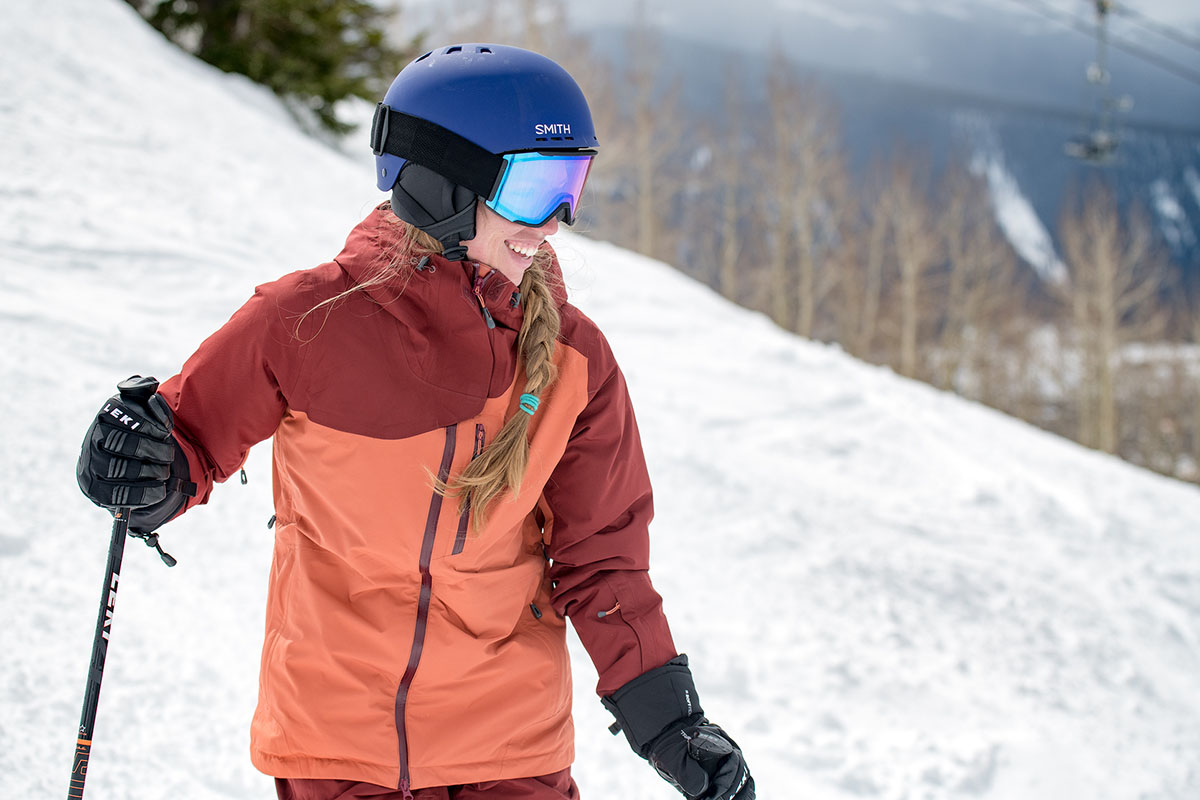
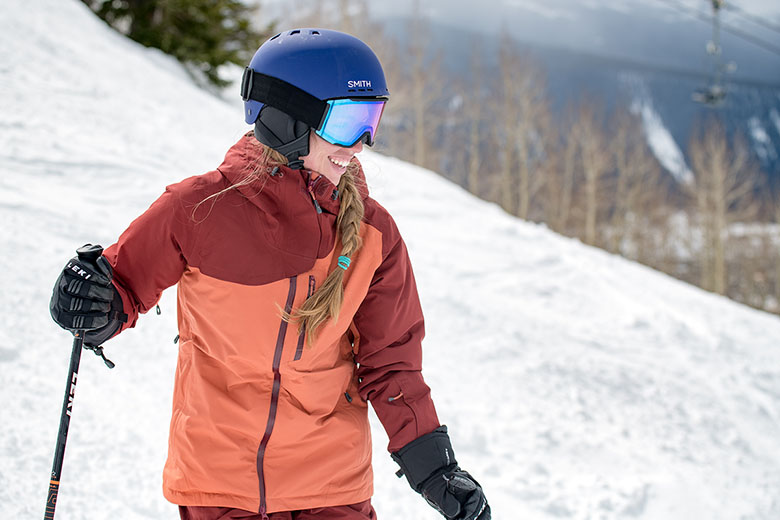
Whether you’re cruising the resort or earning your turns, a ski jacket is an important component of every skier’s kit. Compared to standard winter coats, these jackets come infused with ski-specific features and prioritize durability and coverage for the rigors of life on the slopes. Resort-goers might opt for an insulated piece to stay cozy on the lift, while backcountry skiers will likely prefer a breathable shell that keeps weight low. The good news is that there’s something for every female (or female-identifying) ripper, with stylish designs and colorways and great women’s-specific fits. Below we break down the 18 best women's ski jackets for the 2025 season. For more background information, see our comparison table and buying advice below the picks, along with details about our testing process. And for a wider look at the market, see our article on the best ski jackets, which covers both men's and women's styles.
Editor’s note: We updated this guide on March 13, 2025, to move the Helly Hansen Alphelia up in our rankings, revamp our buying advice section, and incorporate fresh feedback and photos from testing.
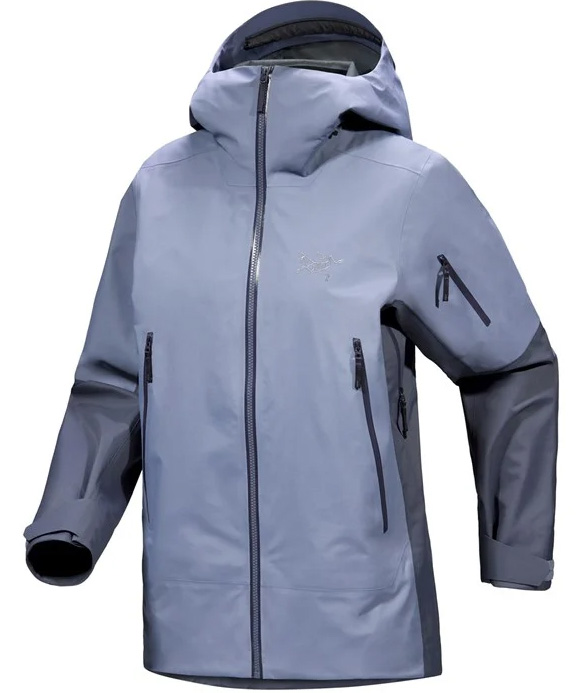 Best for: Resort/backcountry
Best for: Resort/backcountry
Type: Shell
Waterproofing: 3L Gore-Tex ePE
What we like: Technical performance, premium fit, and classy looks.
What we don’t: Expensive; a bit heavy and bulky for dedicated backcountry use.
The best women’s ski jacket combines technical performance with a fun styling and a classy fit, and year after year, no one nails the equation better than Arc’teryx. Within their impressive lineup of ski-specific outerwear, the Sentinel is our favorite all-around jacket for those who split their time between the resort and the backcountry. With its 80-denier (D) face fabric and 3-layer Gore-Tex ePE construction, you get a hardwearing and weatherproof shell, and the light flannel backer adds a little extra protection for frigid chairlift rides. What's more, the feature set is sleek yet fully functional, with smooth-operating pit zips and a water-resistant front zipper, an adjustable hood, and a thoughtful collection of pockets. Added up, the Sentinel is a well-balanced jacket that excels in most conditions and looks good doing it.
It doesn’t get much better for an all-rounder, but the Sentinel does come up short for particularly cold conditions or dedicated backcountry use. The light backer is a nice touch, but you’ll get a lot more warmth with an insulated piece like the Helly Hansen Alphelia or Patagonia Insulated Powder Town below (the Sentinel does come in an insulated version for $850). On the other hand, the thick and rigid shell might be a bit overkill for some uphill-oriented skiers, although it certainly gets the job done for quick sidecountry missions and the odd backcountry day. Gripes aside, the Sentinel is the most well-rounded ski jacket here, and you’ll be hard-pressed to find flaws with Arc’teryx’s exceptional build quality and fit.
Read more: Arc'teryx Sentinel Jacket review (prior version)
See the Arc'teryx Sentinel Jacket
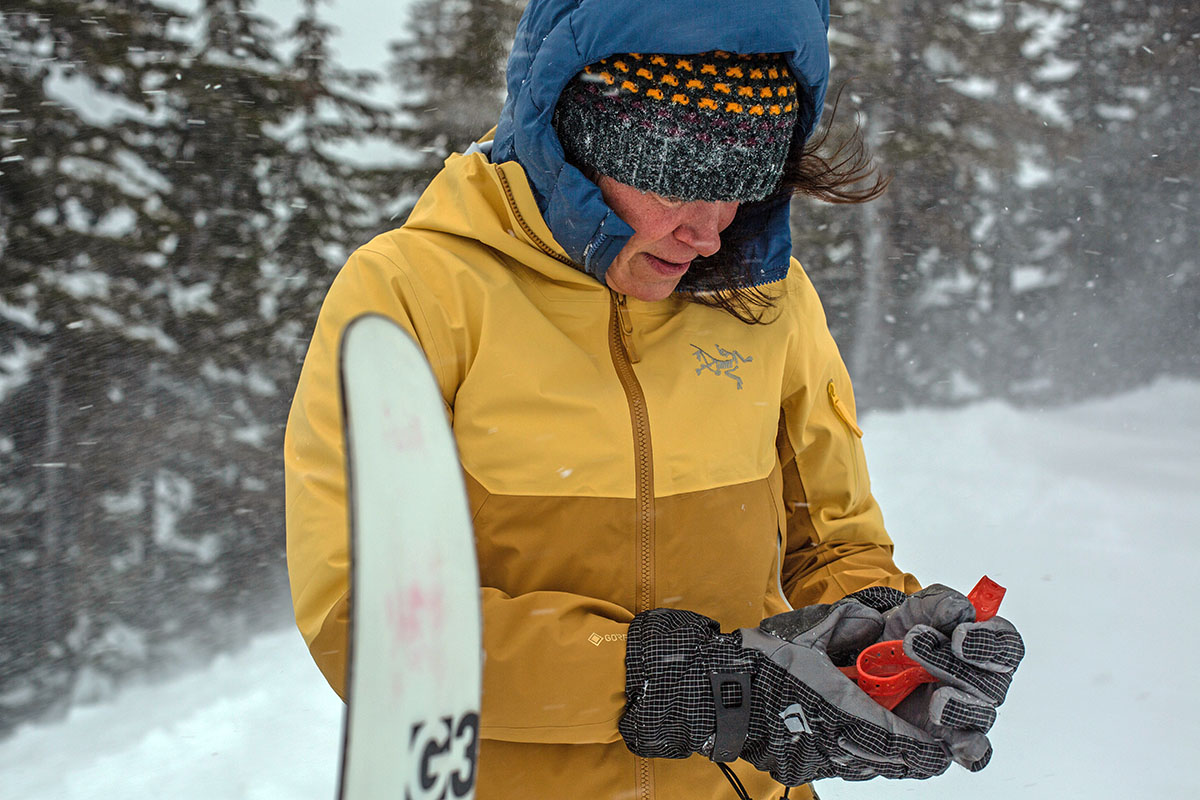
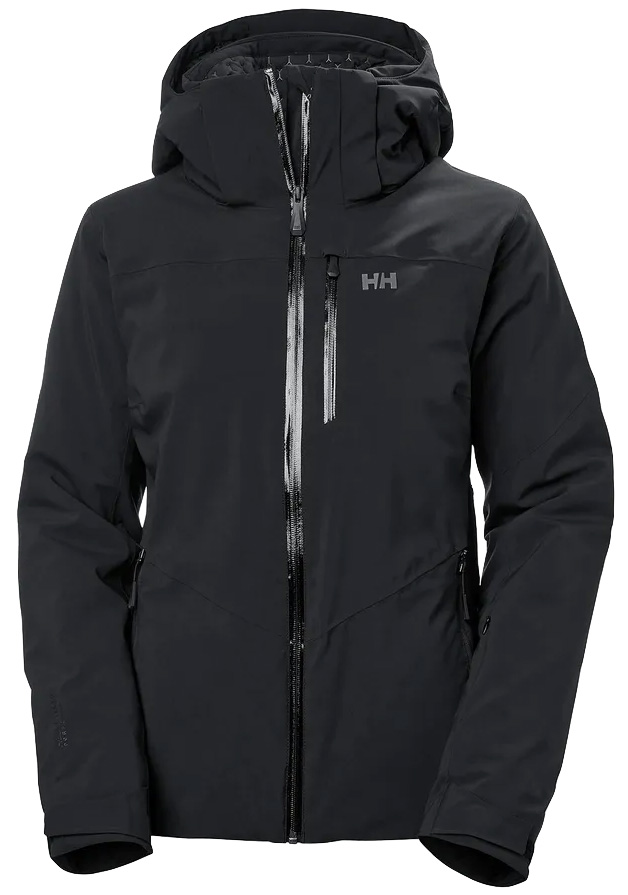 Best for: Resort
Best for: Resort
Type: Insulated (100g PrimaLoft Black)
Waterproofing: 2L Helly Tech Professional
What we like: Stretchy shell fabric, high-quality and stylish design, and cozy feel.
What we don’t: Pricey for a 2-layer jacket and can be too warm for active use.
Taking our top resort spot, Helly Hansen's Alphelia is an extremely comfortable and capable piece built to keep you warm and dry on the stormiest of days. Featuring Helly’s 2-layer Tech Professional waterproof shell along with a moderate level of PrimaLoft Black insulation, the jacket offers great weather protection and a nice boost in warmth compared to a non-insulated shell. Most resort skiers will appreciate the added insulation, which is enough to take the sting out of a chilly chairlift ride but won’t overwhelm you on the way down. The Alphelia also uses four-way stretch fabric throughout, which translates to great freedom of movement for everything from bombing downhill to racking your skis on top of your car. Finally, we love the jacket’s styling, which is super clean, works well for women of all ages, and is offered in a variety of classy colorways.
But while an insulated jacket is a perfectly good companion for resort skiing, the Alphelia isn't a great choice for sidecountry or backcountry use. The 2-layer construction will suffer in terms of breathability compared to 3-layer jackets like the Arc'teryx Sentinel above, and you might want a lighter, uninsulated shell for mild spring days. But it’s hard to beat the added warmth for cold chairlift rides, and the Alphelia comes with some nice touches, including a powder skirt, Recco reflector, and ski-pass pocket on the sleeve. Ski jackets are expensive, and there’s no denying that the Alphelia is an investment, but it’s still a good value for what you get. For a more freeride-oriented design, check out Helly Hansen’s popular Powderqueen 3.0 Jacket.
See the Helly Hansen Alphelia
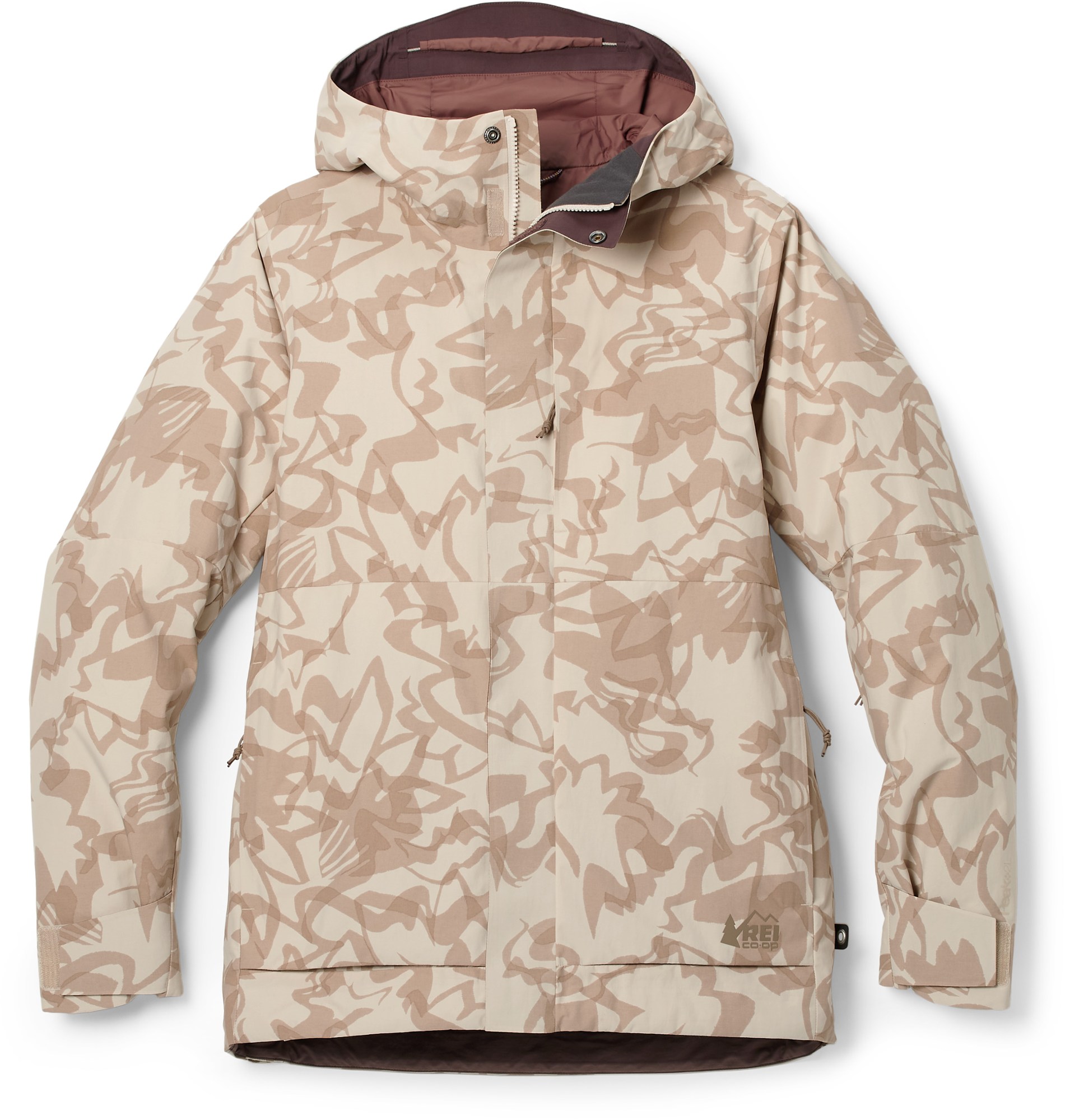 Best for: Resort
Best for: Resort
Type: Insulated (80g & 60g polyester)
Waterproofing: 2L Peak
What we like: An affordable jacket with impressive warmth and ski-specific features.
What we don’t: 2-layer construction offers middling weather protection and breathability.
Ski jackets are undeniably pricey, but that doesn’t mean you need to spend big to get a quality product. Known for their affordable yet functional in-house designs, REI jumped into the ski outerwear market a couple winters back with a small collection of resort-focused pieces, and the Powderbound is a great budget choice. As expected from the Seattle-based brand, this insulated shell is high on value: For $229, you get proprietary 2-layer Peak waterproofing, a moderate amount of synthetic insulation along with a quilted liner, and valuable features like a powder skirt, pit zips, and plenty of well-distributed pockets. Taken together, the Powderbound is a solid option for inbounds riders that will keep you dry and warm without breaking the bank.
But as expected at this price point, the Powderbound isn’t meant to be pushed too hard. REI’s 2-layer Peak membrane isn’t a standout in terms of waterproofing or durability, and the polyester insulation adds both weight and bulk. Expect this jacket to get the job done on most days at the resort, but you’re likely to find its limit in extra-wet conditions. In addition, REI incorporated cheaper fabric flaps over the pockets for protection, which lack the high-end feel you get from coated zippers. And finally, REI's fit and finish consistently comes up short of premium brands like Patagonia and Arc’teryx. But for a purpose-built budget piece that ticks the right boxes for season-long use, the Powderbound is well worth checking out.
See the REI Co-op Powderbound
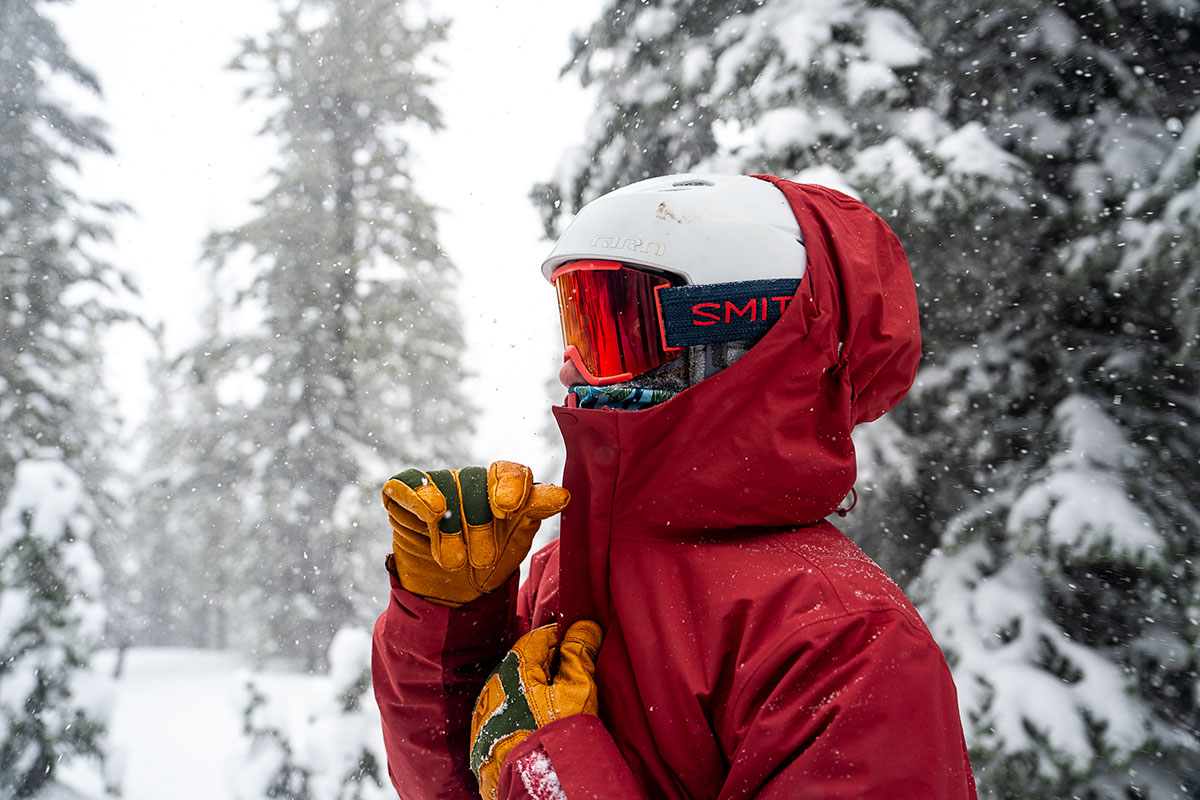
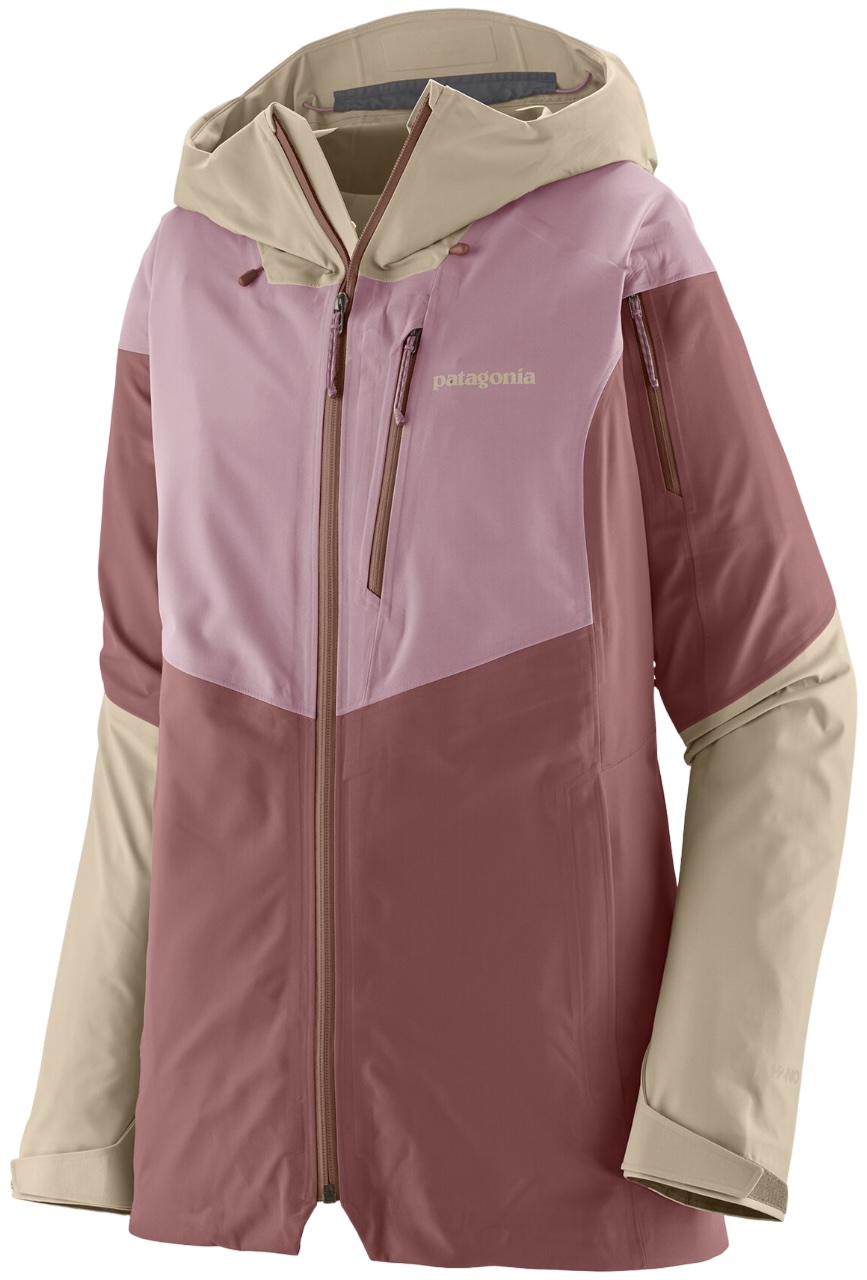 Best for: Backcountry/resort
Best for: Backcountry/resort
Type: Shell
Waterproofing: 3L H2No Performance Standard
What we like: Stretchy construction offers mobility and comfort for ski touring.
What we don’t: You’ll get better weather protection with a rigid hardshell.
Patagonia offers a complete lineup of premium ski and snowboard jackets, and their reasonably priced SnowDrifter is our favorite design for backcountry skiers. Combining a stretchy, softshell-like face fabric with proprietary 3-layer construction, the SnowDrifter places a premium on comfort and mobility without compromising much in the way of weather protection. Compared to a standard hardshell jacket, it’s noticeably less rigid and restrictive, which is great news for the demands of uphill travel. Further, the added “give” in the design, combined with a soft moisture-wicking liner, non-insulated construction, and pit zips, translates to excellent breathability. And the rest of the jacket is streamlined yet functional, with a built-in powder skirt, five handy pockets (including an internal dump pocket great for warming goggles or gloves), and an embedded Recco reflector.
What’s not to like about the Patagonia SnowDrifter? First, we were a little disappointed to see that Patagonia opted for a 50D face fabric with the latest iteration, while past versions were 75D. We haven’t had any durability-related issues after extensive testing, but the latest model has less of a bombproof feel overall. We also wish there were dual dump pockets for stashing climbing skins (you only get one), which strikes us as a questionable omission given the jacket’s backcountry slant. Finally, the stretchy face fabric sacrifices some protection in high winds and wet snow compared to a burly Gore-Tex or Gore-Tex Pro model, but in most cases, the trade-offs are worth it for high-output efforts on the skin track. In the end, the SnowDrifter balances its priorities incredibly well while managing to keep weight respectably low, earning it our vote as the best backcountry design of the season.
Read more: Patagonia SnowDrifter Jacket review
See the Patagonia SnowDrifter
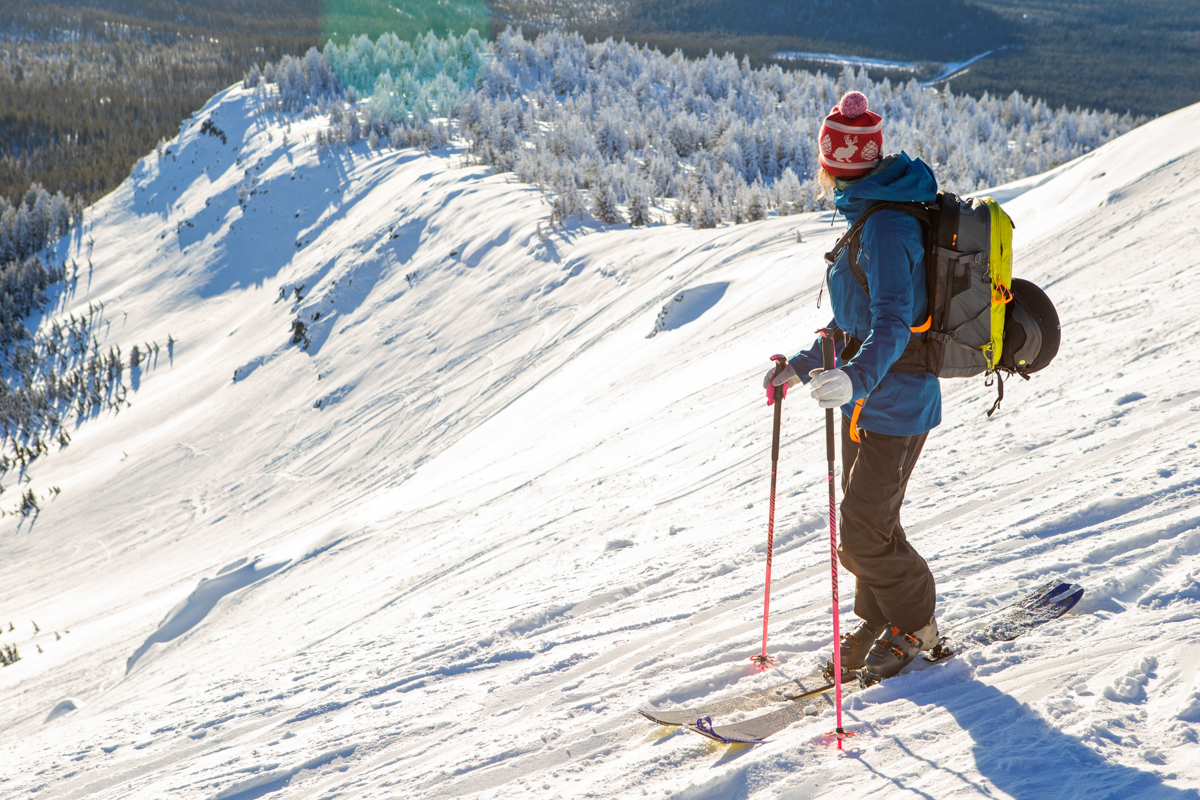
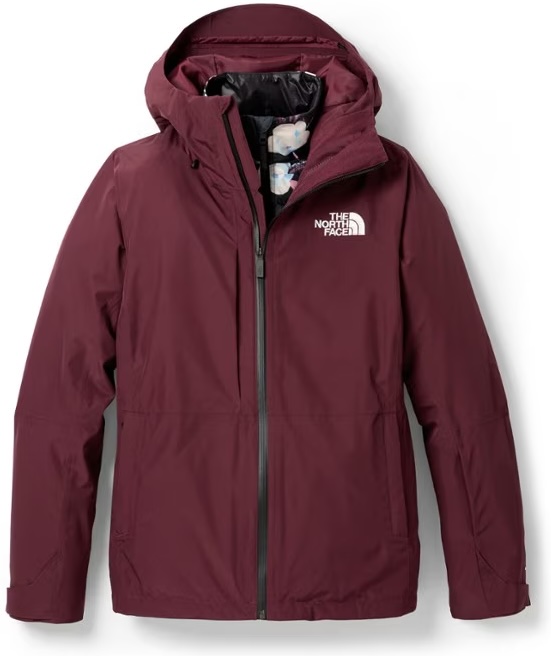 Best for: Resort
Best for: Resort
Type: 3-in-1 (11 g/sq. ft. ThermoBall & 60g Heatseeker Eco)
Waterproofing: 2L DryVent
What we like: 3-in-1 value and quality ThermoBall insulation.
What we don’t: Zip-in design is cumbersome and midlayer pockets lack zippers.
If you’re putting together your kit from scratch or looking to save some money, a 3-in-1 jacket can be a really nice option. In one fell swoop, you get a standalone waterproof shell, an insulating midlayer, and—put together—an insulated ski jacket. The versatility and value here are second to none. And while many jackets in this category are of the budget variety (like the Columbia Bugaboo III below), The North Face’s ThermoBall Snow Triclimate is a nice upgrade at a good price. The 2-layer DryVent shell offers great coverage and modern resort styling, including features like a contoured waist, drop-tail hem, and sleek water-resistant front zipper. But the main event here is the ThermoBall synthetic midlayer, which we've found does a pretty good impression of a lofty down piece—all while continuing to insulate when wet.
We understand the appeal of a 3-in-1 design, especially if you’re shopping for both a ski jacket and a midlayer at once. However, it’s important to note that the zip-in system doesn’t add much value in terms of warmth or comfort. In fact, 3-in-1s are more prone to drafts than standard insulated designs, and the connected midlayer limits access to your interior pockets (note: The ThermoBall jacket features open hand pockets with no zips). Further, the shell’s extra zippers can be unsightly when worn alone, and the additional materials add weight and bulk. In the end, we prefer the versatility of separating our shell and midlayer, with the main downside being the need to make a decision on two jackets rather than one. But for those who want the convenience of a 3-in-1 purchase, the ThermoBall Snow Triclimate is a solid option.
See the TNF ThermoBall Snow Triclimate
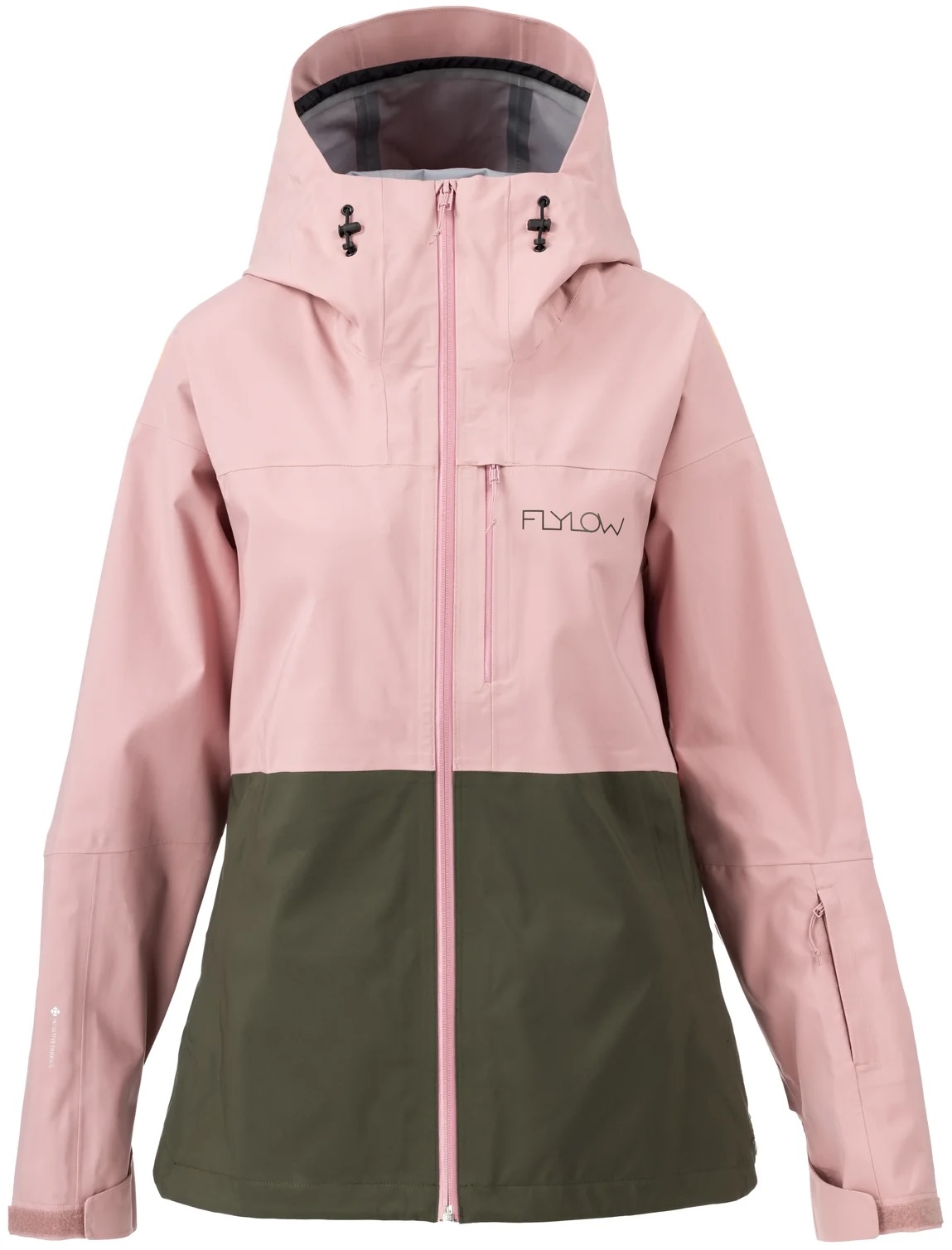 Best for: Backcountry/resort
Best for: Backcountry/resort
Type: Shell
Waterproofing: 3L Tactic
What we like: Comfortable and stretchy like a softshell but with reliable 3-layer protection.
What we don’t: Lacks the impervious feel of Gore-Tex hardshells.
Colorado-based Flylow Gear has gained serious traction in recent years for their modern styling and materials, and their Lucy Jacket was quick to win us over in testing. In short, the Lucy combines the best attributes of softshell and hardshell jackets: For jaunts into the sidecountry or short backcountry tours, the stretchy build and supple interior provide excellent mobility and comfort. If inclement weather rolls in, the 3-layer waterproof membrane does a nice job sealing out snow and wind, and the tall collar leaves very little skin exposed. Last but not least, all of the materials and components have a high-quality feel, and the attractive design has earned us countless compliments over the years (it also looks pretty fresh after multiple seasons of use).
Similar to the SnowDrifter above, the emphasis on comfort and stretch does impact the Flylow’s bombproof feel. Its DWR coating sheds snow effectively, but it’s not as well equipped for particularly wet and nasty days (those who get out on storm days in the Pacific Northwest likely will want more protection). We also were a little disappointed by the organization: The jacket lacks an internal dump pocket for stashing goggles or climbing skins, and the chest pockets were too small to fit a large phone (in our case, an iPhone 11 Pro Max). The SnowDrifter remains our category favorite with a slightly better design, but the Flylow nevertheless hits a really nice middle ground of comfort and performance for mixed resort and backcountry use. And the cherry on top: We've received more compliments while wearing the Lucy than any other ski jacket.
Read more: Flylow Gear Lucy Jacket review (prior version)
See the Flylow Gear Lucy Jacket
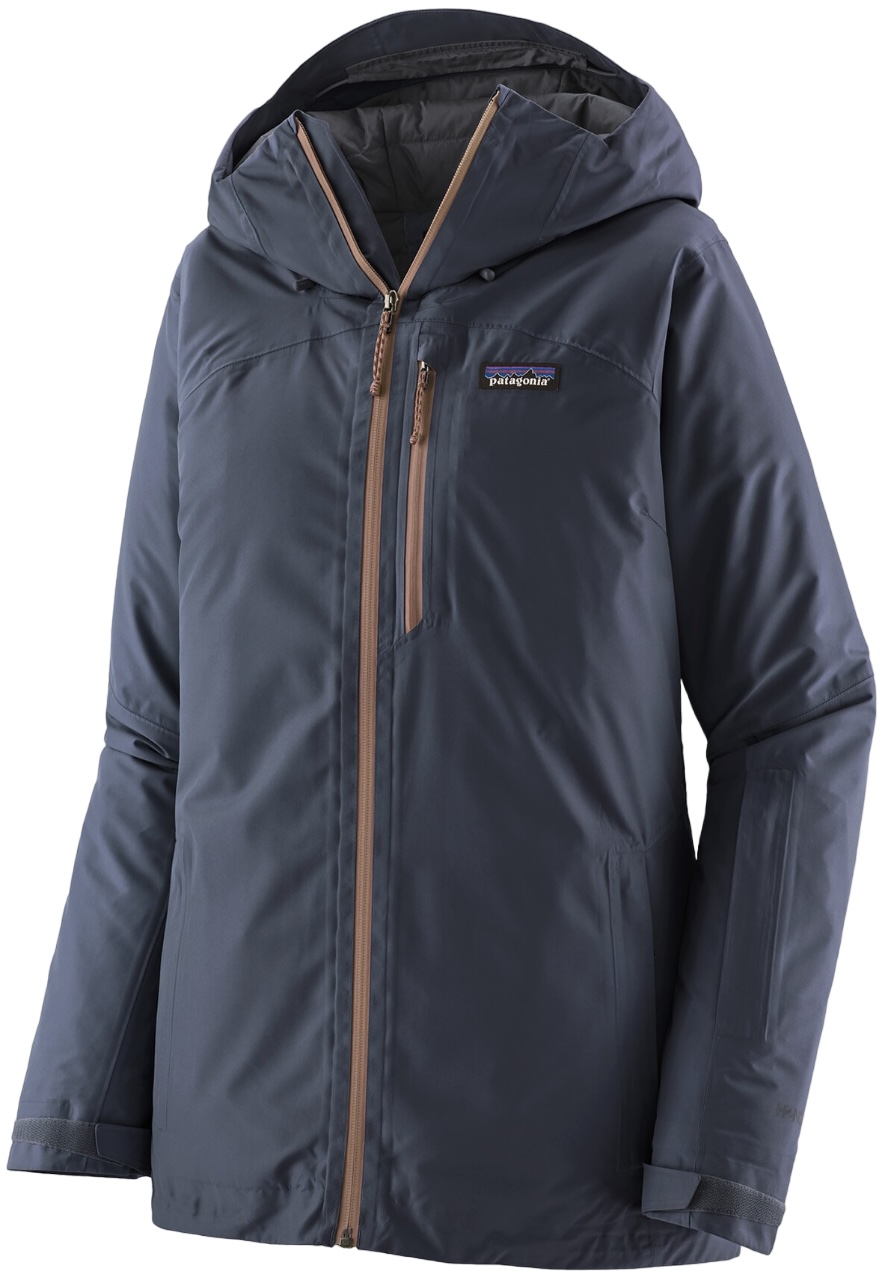 Best for: Resort
Best for: Resort
Type: Insulated (80g & 40g Thermogreen)
Waterproofing: 2L H2No Performance Standard
What we like: A high-quality resort jacket at a great price.
What we don’t: Too warm for mild conditions.
Patagonia’s Powder Town is a true looker of a jacket and has the performance specs to back it up. It’s offered in a range of styles, but we like the insulated model best: 80-gram (g) synthetic insulation keeps the body warm, and we appreciate the thoughtful touches like a drop-in interior pocket for ski goggles and a soft-touch taffeta lining. And with a 31-inch center back length, you get great coverage and modern styling. While the in-house H2No waterproof membrane doesn’t knock it out of the park in terms of breathability, this shouldn’t be a primary concern for most resort skiers, and you do get underarm vents to dump heat on warm spring days.
The Powder Town highlights Patagonia's strong commitment to the environment, with a PFAS-free DWR coating and recycled shell, lining, and insulation. But although there's a lot of tech built into this jacket, it's still limited to resort use: The 2-layer construction is lacking in breathability compared to more premium 3-layer competitors, and the insulation means you’ll quickly work up a sweat during sidecountry hikes or active descents. The uninsulated variation of the Powder Town ($349) is the better choice in these situations, although its mesh liner is a step down in comfort from the soft taffeta of the synthetic-filled model. Patagonia also offers the Powder Town in a 3-in-1 variation, but it’s a sizable bump in price at $499. But for a cozy jacket that can keep up on chilly chairlift rides, the Insulated Powder Town comes at a great price with Patagonia's brand cachet to boot.
Read more: Patagonia Insulated Powder Town Jacket review
See the Patagonia Insulated Powder Town
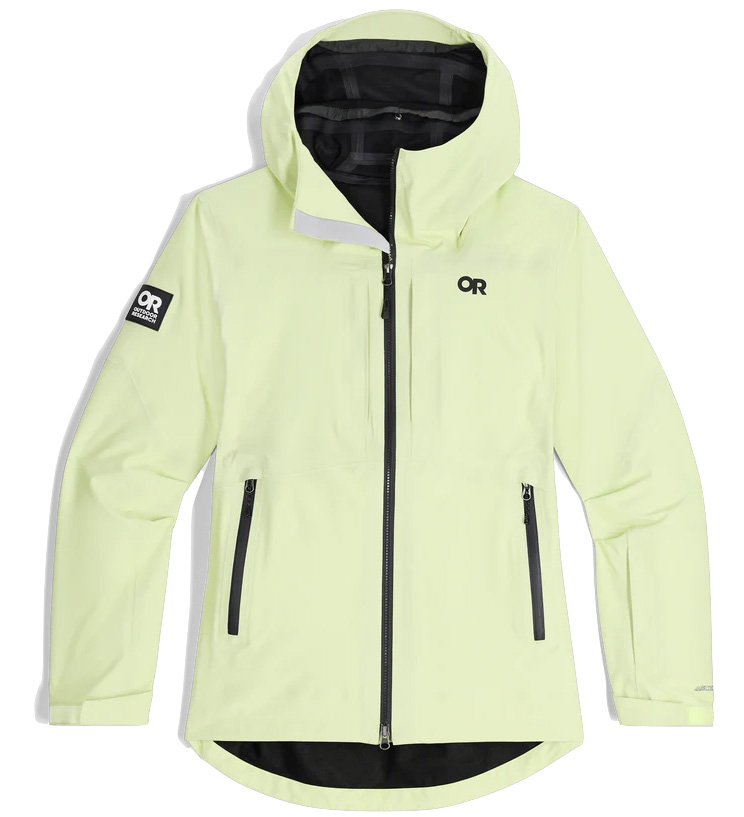 Best for: Backcountry
Best for: Backcountry
Type: Shell
Waterproofing: 3L AscentShell
What we like: AscentShell is stretchy and breathable yet still fully waterproof; a solid value for what you get.
What we don’t: Lacks some ski-specific features.
In-house fabric technologies often fall short, but Outdoor Research’s AscentShell is an exception. We’ve tested this waterproof membrane on a number of jackets at this point, including the Skytour’s predecessor (the Skyward II), which performed flawlessly throughout a full season of backcountry use. The fabric stretches like a softshell, is extremely breathable with an air-permeable design, and is fully waterproof. And to top it off, the Skytour is one of the lightest designs here, clocking in at an impressive 1 pound 4.5 ounces, while retaining a functional feature set including plenty of interior and exterior pockets, pit zips, and a hood that adjusts to fit both climbing and ski helmets. It’s not the most versatile option for resort use—we’d recommend a more durable and protective jacket for lift-served days—but the Skytour is purpose-built to keep you cool and comfortable outside the ropes.
What are you giving up at the Skytour’s $429 price point? Build quality is a step down from the ridiculously high attention to detail that you get from the Arc’teryx Sentinel above, and the OR lacks features like a powder skirt and Recco reflector. In addition, the AscentShell fabric doesn’t have the batten-down-the-hatches feel of the Gore-Tex jackets here, and one tester found the exterior very quick to wet out during a shower test (to simulate a deluge like you might experience in maritime climates). Finally, the Skytour’s 31.5-inch center back length is longer than most ski jackets here, which could be too much or just right depending on your priorities (for such a lightweight, backcountry-inspired design, it's a little long and overkill for us, especially when paired with a bib). Nitpicks aside, we’re big fans of the Skytour’s well-balanced construction and feature set, making it a great choice for those who like to earn their turns.
See the Outdoor Research Skytour AscentShell
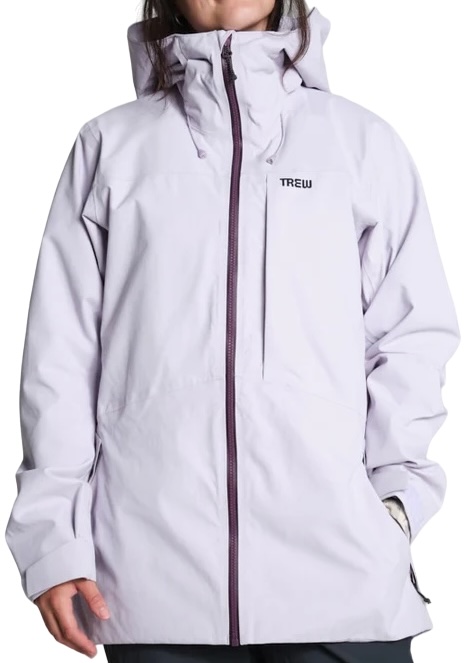 Best for: Resort
Best for: Resort
Type: Shell
Waterproofing: 2L PNW
What we like: Great coverage, durable, and functional feature set.
What we don’t: Heavy and lacking in breathability.
For those who haven’t been introduced, Trew Gear is an Oregon-based company that excels in the mid-range to high-end resort market. Their designs offer a really nice balance of performance and style, with durable and highly waterproof fabrics alongside loud colorways and baggy freeride vibes. The women’s Astoria is Trew’s core uninsulated 2-layer jacket that hits a very desirable combination of price ($319), quality, and coverage. Thanks to its long cut and burly shell (the 200 x 320D nylon is easily the thickest here), the jacket excels in the kind of conditions you learn to accept in the Pacific Northwest: wet, rowdy, and—at times—deep.
Like most 2-layer ski jackets, the Astoria features a hanging liner that adds bulk and weight (it’s one of the heaviest non-insulated shells here at 1 lb. 12 oz.) and impacts breathability. As a result, we don’t recommend this jacket for particularly rambunctious skiers who tend to build heat, or anyone splitting their time between the backcountry and the resort. But for casual resort skiers, all the requisite features are here—including a high-quality waterproof membrane with fully taped seams, water-resistant zippers, a removable powder skirt, and an adjustable hood that's generously sized—along with style points galore. For a more premium 3-layer option, check out their Stella Primo below.
Read more: Trew Gear Astoria Jacket review
See the Trew Gear Astoria
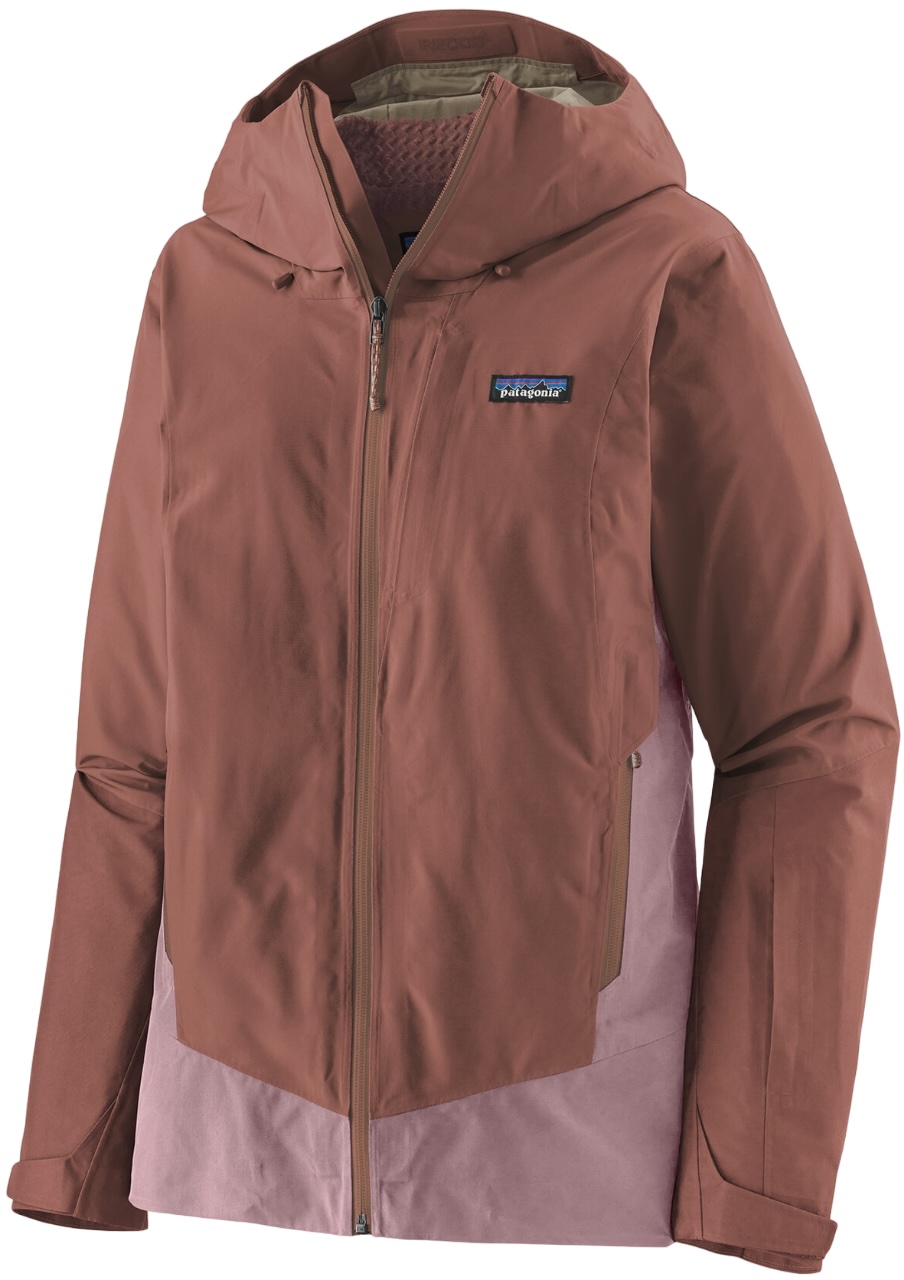 Best for: Resort
Best for: Resort
Type: Shell (fleece liner)
Waterproofing: 2L Gore-Tex ePE
What we like: Durable materials, soft interior lining, and impressive sustainability measures.
What we don’t: Expensive for a 2-layer design.
Patagonia’s Powder Town above is their entry-level design for resort skiers, but the Storm Shift offers a step up in just about every way. You get reliable protection by way of a premium Gore-Tex membrane that’s kept us bone-dry in typical Pacific Northwest weather, along with a beefy (150D) shell fabric that’s well suited for aggressive riding and frequent chairlift rides. We were pleasantly surprised by the thick shell’s flexibility and mobility, and the soft lining along the interior—which combines zigzag fleece and a smooth taffeta material—provides a nice dose of comfort and breathable warmth. Rounding out the design is a full feature set that includes plenty of storage, a snow skirt, pit zips, and more. Added up, the Storm Shift is a highly capable resort companion and one of our favorite all-mountain jackets on the market.
As we’ve come to expect from Patagonia, the Storm Shift is built with a keen eye toward sustainability, including a fully PFAS-free construction and the use of recycled materials throughout. One downside to the more environmentally friendly water-repellent coating is that it’s quicker to deteriorate compared to traditional treatments (fortunately, it’s easy to re-apply, and the Gore-Tex membrane is very confidence-inspiring). For many, the bigger issue will be price: At $499, the Storm Shift isn’t a particularly strong value, especially considering that you get fabric flaps rather than sleeker water-resistant zippers over all of the exposed pockets and openings. Finally, we wish Patagonia had positioned the internal and external chest pockets on opposite sides, as the current layout can lead to excess bulk when both are in use. Still, we're big fans of the Storm Shift and consider it one of the highest-quality resort shells available.
See the Patagonia Storm Shift
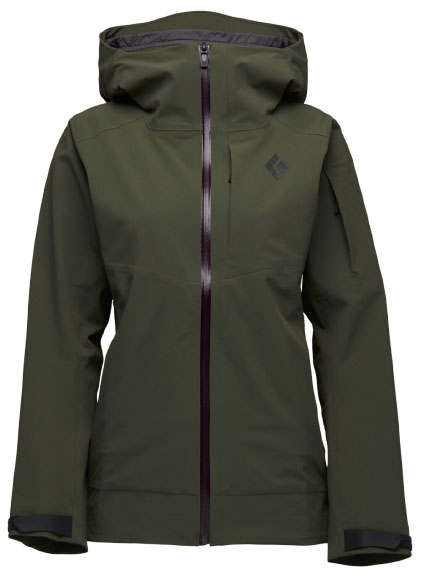 Best for: Resort/backcountry
Best for: Resort/backcountry
Type: Shell
Waterproofing: 3L BD.dry
What we like: A versatile jacket for both the resort and backcountry.
What we don’t: Black Diamond’s build quality falls short of premium competitors like Arc'teryx and Patagonia.
Black Diamond specializes in technical climbing gear, so their expansion to performance-ready ski apparel feels logical. While still a relatively new player in the space, they’ve wasted no time assembling a quality lineup, and we particularly like their Recon Stretch Shell. An all-rounder that excels both in and out of bounds, the Recon combines Black Diamond’s in-house BD.dry membrane with a stretchy shell, resulting in an excellent combination of protection, comfort, and mobility. Those who spend a lot of time on the skin track will appreciate the removable powder skirt and internal mesh dump pockets for stashing climbing skins, while resort riders can take advantage of niceties like a lift pass pocket and ski helmet-compatible hood.
Similar to the Patagonia SnowDrifter above, the BD Recon Stretch is an insulated shell that stands out for being both highly waterproof and breathable. Both jackets feature stretchy shell fabrics and proprietary 3-layer builds, although the BD is heavier (by 2.3 oz.) and has a bulkier feel, especially during movement-dependent efforts like bootpacking into the sidecountry. Additionally, Black Diamond’s build quality and fit can be hit or miss, and the Recon in particular has a slightly boxy cut that may feel overly roomy in the hips for those with narrower frames. For around the same price, we consider the SnowDrifter to be the slightly less compromised piece, but the Recon nevertheless is a versatile option for 50/50 resort and backcountry use.
See the BD Recon Stretch Shell
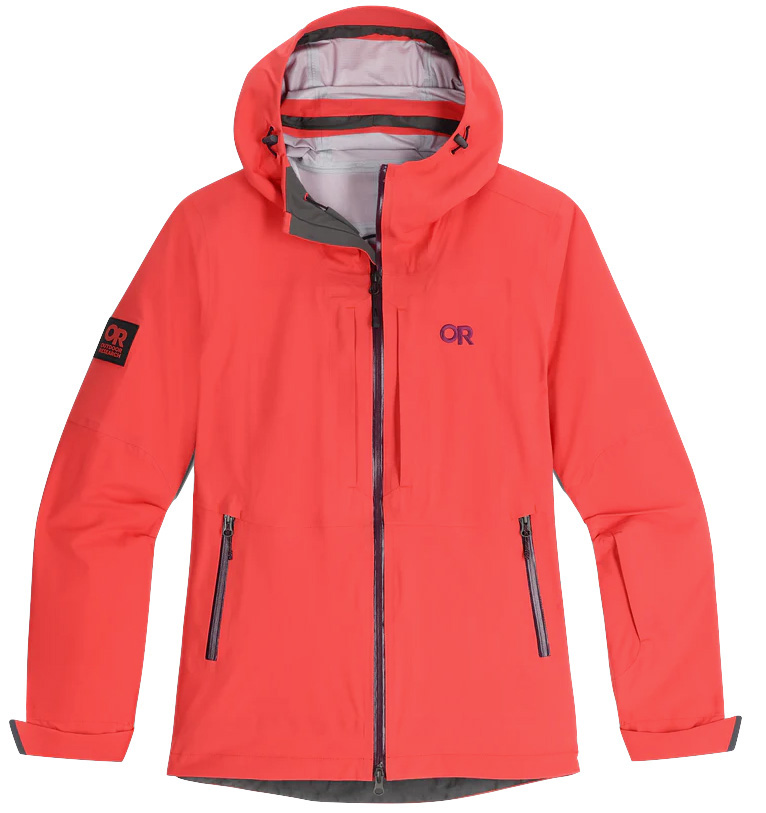 Best for: Backcountry/resort
Best for: Backcountry/resort
Type: Shell
Waterproofing: 3L Pertex Shield
What we like: The most affordable 3-layer ski jacket here.
What we don’t: Too thin for dedicated resort use.
Outdoor Research is known for providing a lot of bang for your buck, and their versatile Carbide delivers in spades. Featuring a 3-layer Pertex Shield waterproof membrane, this jacket goes head-to-head with premium designs like the Patagonia SnowDrifter and Flylow Lucy above, all while checking in at a very affordable $329. Similar to the Patagonia and Flylow, the Carbide is competitively lightweight at 1 pound 2.8 ounces—thanks in large part to its thin 40D shell and modest 29-inch center back length—making it an excellent choice for minimalist backcountry-goers. But despite the streamlined build, OR still packs in all the requisite ski-specific features, including pit zips, a powder skirt, a forearm pocket (great for storing your ski pass), and a smooth-running, two-way front zipper.
Outdoor Research touts the Carbide as a do-it-all jacket for both the front- and backcountry, but we hesitate to recommend it as a dedicated resort design. Our main hesitation is the relatively thin shell, which lacks the toughness required for day-long exposure and the rigors of inbounds use. And while you get some extra comfort and warmth from the tricot knit backer, some resort-goers will prefer the added assurance of a fully insulated design. But for those who like to split their time in and out of bounds, the Carbide is the most affordable 3-layer design here and a competitively versatile choice. For a resort-specific jacket at the same price point, check out Outdoor Research’s Snowcrew ($349), which features 2-layer in-house waterproofing and a healthy dose of VerticalX insulation.
See the Outdoor Research Carbide
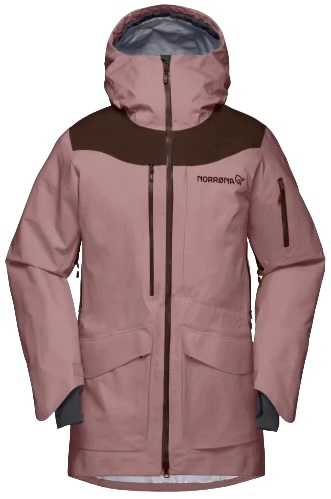 Best for: Backcountry/resort
Best for: Backcountry/resort
Type: Shell
Waterproofing: 3L Gore-Tex ePE
What we like: Top-end protection and durability in a fun mountain style.
What we don’t: Serious backcountry-goers will want a more streamlined piece.
Norrøna doesn’t have the name recognition of Arc’teryx, but they’re one of only a few brands that can come close in terms of attention to detail and outright performance. Their Tamok Gore-Tex Jacket is a case in point: This beautifully crafted shell is built for deep days with Gore’s trusted 3-layer laminate and an extended back length (32 in.), includes a tall collar and helmet-friendly hood, and does it all in a fresh, freeride style. There’s sufficient organization for storing backcountry essentials, including hipbelt-friendly external dump pockets, and generous pit zips and a chest vent allow you to regulate your temperature throughout the day. Tack on a reasonable 1-pound-7.5-ounce weight, cozy hand gaiters, Gore's soft C-Knit backer, and a classy (albeit small) colorway selection, and we can see why the Tamok gets so much hype.
The Tamok’s combination of style and performance makes it a great pick for those double-dipping both in and out of bounds, but serious backcountry-goers might want to take a look at Norrøna’s classic Lofoten. For $799, this jacket is a technical masterpiece, shedding about 2 ounces off the Tamok with slightly thinner fabrics, a form-fitting build, and more functional hand pockets. Both are ridiculously expensive, but the price might feel more reasonable when you consider that Arc’teryx’s $750 Sentinel above uses a downgraded Gore-Tex membrane (the Lofoten uses their top-end “Pro” waterproofing). Overall, we give the nod to the Sentinel for its lighter build (1 lb. 5.3 oz.) and do-everything nature, but Norrøna’s backcountry offerings are well worth a look for committed riders.
See the Norrøna Tamok Gore-Tex
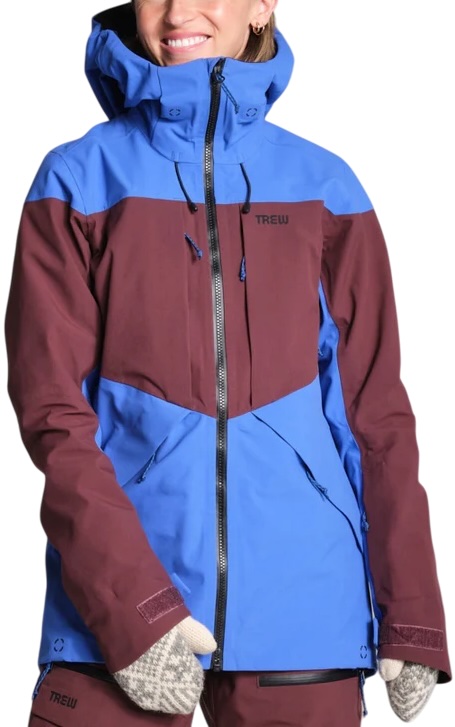 Best for: Resort
Best for: Resort
Type: Shell
Waterproofing: 3L PNW Primo
What we like: Premium build quality and great women’s-specific fit and styling.
What we don’t: Too heavy and bulky for dedicated backcountry use.
Trew Gear’s Astoria above is one of our favorite recommendations for those looking for a stylish resort jacket that won’t break the bank, but their Stella Primo takes things to the next level. Featuring a 3-layer construction that combines Trew’s in-house PNW Primo membrane with a hardwearing woven shell, the Stella is much sleeker and noticeably more breathable, making it a great choice for serious skiers who split their time between the resort and backcountry. Tack on a refined women’s-specific fit and a host of stylish additions—including generous hand and chest pockets (the former extend all the way down to the hem), large cuffs, and a range of bright colorways—and the result is a ski jacket that’s fun to wear no matter what Mother Nature throws your way.
The Stella Primo stands out from other 3-layer ski shells with a thick, almost softshell-like fabric that incorporates a bit of stretch. As a result, it’s high on comfort, durability, and weatherproofing (it performed flawlessly in a range of harsh and wet conditions), but it’s also a lot of jacket. We expected the Stella to be a go-to backcountry shell, but its heavy build is simply unappealing for high-exertion days. Further, the flared cuffs are fairly polarizing and—along with the extra-long pass pocket on the sleeve—leave a massive bunch of fabric when cinched. But as a 90/10 resort and backcountry piece, it’s a compelling design. If you're looking for less bulk and a slightly different cut, the Stella Classic ($459) has a lighter construction and snazzy hem, though its stretch and durability can't match that of the Primo. In terms of fit, the Stella has a “relaxed style,” and we wound up sizing down in the Primo and being very happy with the athletic fit.
Read more: Trew Gear Stella Primo Jacket review
See the Trew Gear Stella Primo
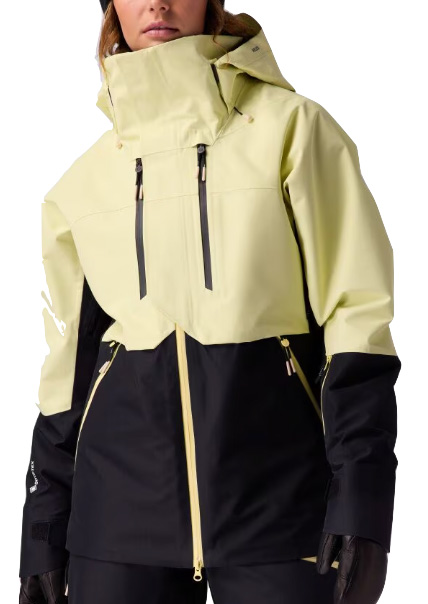 Best for: Resort
Best for: Resort
Type: Shell
Waterproofing: 2L Gore-Tex ePE
What we like: A super tough and feature-rich hardshell.
What we don’t: Stiff, bulky, and heavy.
Popular outdoor retailer Backcountry has entered the apparel world with a surprisingly complete line of outerwear, insulation, and more. The Cottonwoods Jacket (also offered in a matching bib) is their premium resort shell, highlighted by a 2-layer Gore-Tex ePE construction and extremely burly face fabric. Organization-wise, there are a grand total of seven pockets—five along the exterior and two inside—that make it easy to distribute gear and snacks, and Backcountry nailed the basics with easy adjustments at the hood, cuffs, and hem, as well as soft hand gaiters for an extra dose of comfort. It all adds up to an impressively hardwearing and functional jacket that isn't out-of-touch price-wise at $449.
It’s really hard to overstate the robust and bombproof feel of this jacket, which has become a go-to choice for storm days at the resort. The downside to this construction is that the Backcountry is among the stiffest and least comfortable jackets on our list and considerably less supple and mobile than the 80D Arc'teryx Sentinel (unfortunately, Backcountry does not specify a fabric thickness, but the jacket is undeniably hefty). For this reason, we don’t recommend the Cottonwoods for backcountry use, and you might want a lighter and airier shell for bluebird spring days at the resort. But for a squall-ready jacket that you can truly hunker down in—we love the tall collar that zips all the way up to the nose—the Cottonwoods is a capable choice that won’t break the bank.
See the Backcountry Cottonwoods
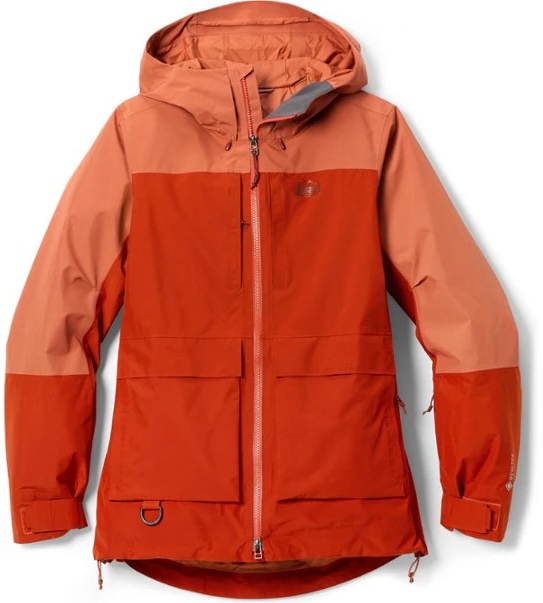 Best for: Resort
Best for: Resort
Type: Shell
Waterproofing: 2L Gore-Tex ePE
What we like: Reliable Gore-Tex waterproofing at a good price; plus sizes offered.
What we don’t: Trew Gear’s Astoria above costs the same and has a more comfortable and refined build.
The second REI design to make our list this season is their First Chair GTX Jacket, which is a more performance-focused alternative to the Powderbound above. Unlike the Powderbound, the First Chair is uninsulated and features an upgraded Gore-Tex membrane for more reliable protection in the wet. The rest of the build is high on value, too, from the smooth interior to valuable features like a powder skirt, pit zips, and seven well-distributed pockets. We also appreciate that the jacket is built with the environment in mind, utilizing a recycled shell and lining, bluesign-approved and Fair Trade-certified materials, and Gore's PFAS-free ePE membrane. Offered in a nice range of colors and sizes—including up to 3X for women—the First Chair is a solid all-around option, particularly for resort riders.
As expected for a jacket at this price point, the First Chair isn’t a particularly good breather. Gore’s 2-layer construction doesn’t allow for much airflow compared to their 3-layer membranes, and the interior lining adds both weight and bulk. Other signs of cost-cutting include cheaper fabric flaps over the zippers on the pockets and pit zips (the front zipper is coated, however). Finally, compared to the equally priced Trew Gear Astoria above, the REI is lighter but has a more generic fit, lacks the quality feel on touch points like the zipper pulls and hood cinches, and isn’t as soft along the interior. But if you prioritize Gore-Tex waterproofing, storage, and value—an admittedly enticing mix—the First Chair is well worth checking out.
See the REI Co-op First Chair GTX
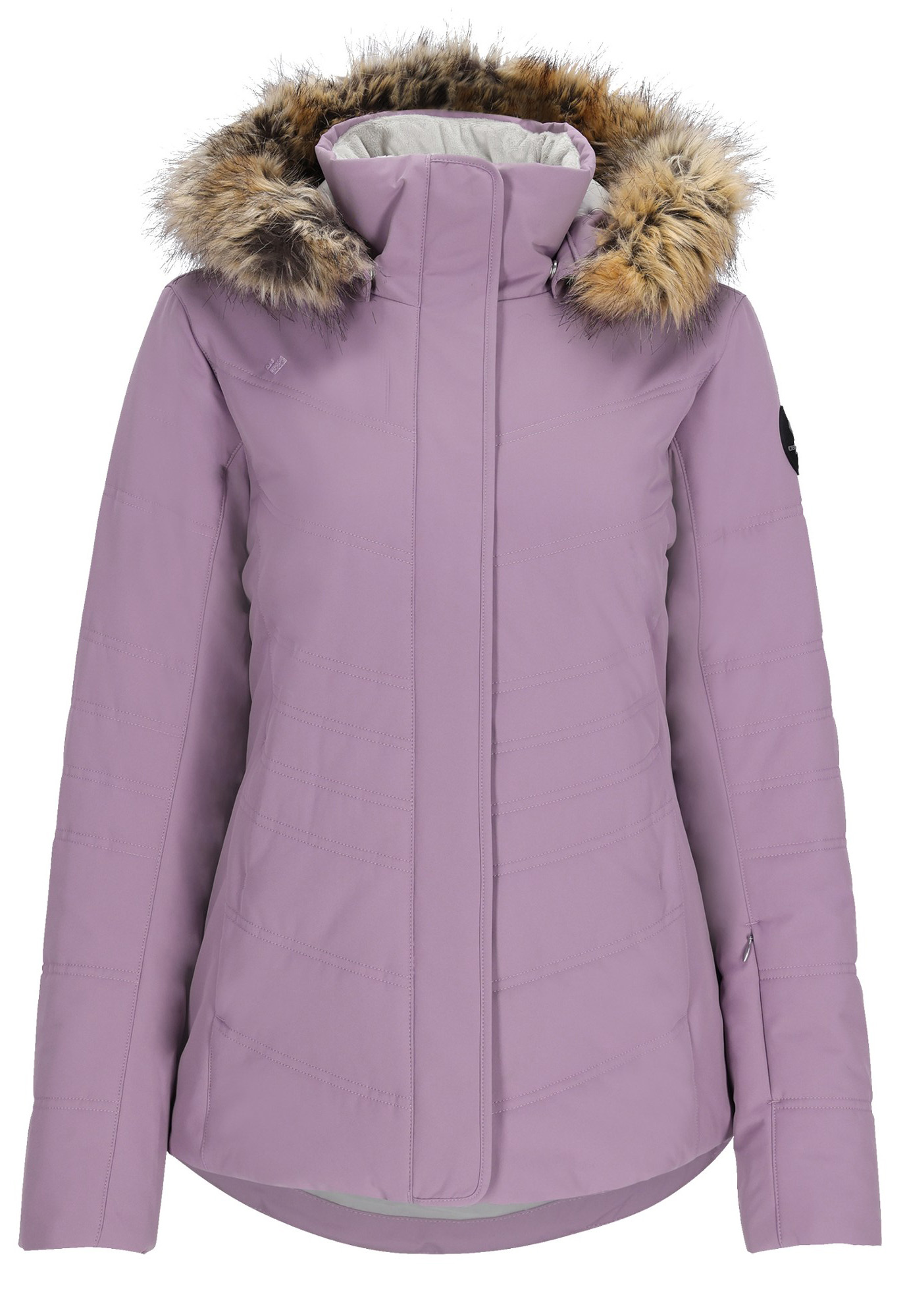 Best for: Resort
Best for: Resort
Type: Insulated (130g & 40g PrimaLoft Rise Black Eco)
Waterproofing: 2L HydroBlock Sport
What we like: Women’s-specific fit and that classic resort style.
What we don’t: Not particularly waterproof and middling breathability.
Obermeyer used to be synonymous with ski jackets, but with street style being the new norm on the slopes, their more traditional offerings have grown long in the tooth. The Tuscany II, however, has stood the test of time and remains a nice choice for casual resort skiers. Those looking for a tastefully feminine design will find a lot to like here, with a form-fitting shape and cozy faux-fur trim on the hood, along with a soft face fabric that’s available in a number of classy colorways. And despite its closer fit, the Tuscany does accommodate a midlayer underneath, although you might not need the added warmth thanks to the jacket’s thick, 130g insulation throughout (40g in the hood).
The Obermeyer will get the job done on cold and snowy days, but when the mercury rises and the snow turns to slush, it will show its weaknesses. For one, the jacket’s HydroBlock Sport laminate lacks the quality of membranes like Gore-Tex and will wet out in sustained moisture. To be sure, you can get away with the Tuscany in colder climates like Colorado and the Northeast, but we don't recommend it for the Pacific Northwest. Second, it does not feature pit zips, and with heavy insulation, it can really build heat during mild days on the slopes. But the jacket will blend in on the city streets more than most, which is the sort of crossover appeal many women want. For a warm, stylish, and versatile design, it’s no secret why the Tuscany II remains popular year after year.
See the Obermeyer Tuscany II
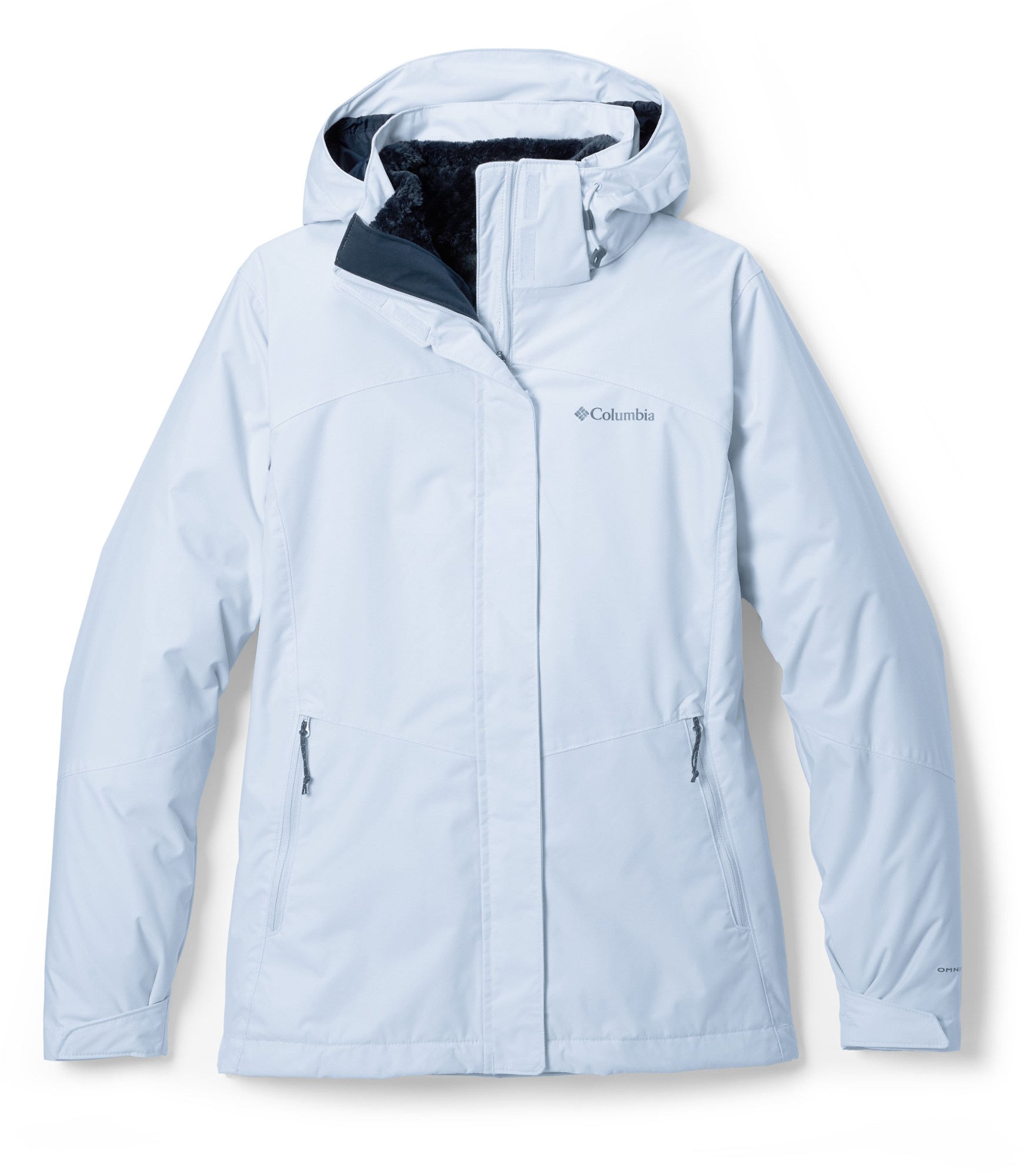 Best for: Resort
Best for: Resort
Type: 3-in-1 (fleece)
Waterproofing: 2L Omni-Tech
What we like: An affordable way to get out on the slopes.
What we don’t: Cheap construction and generic fit.
The essential duties of a resort jacket are to keep you warm and protected from moisture and wind and provide enough storage for the basics. Columbia’s answer to these needs is the Bugaboo Interchange, a 3-in-1 ski jacket at a very attractive price point. Perfect for wintery days on the slopes, you get a good deal of warmth with a fleece zip-out jacket and Columbia’s signature (and somewhat polarizing) Omni-Heat reflective lining. The silvery interior is a little too disco for us when we slip it off, but it does feel like it’s working by radiating body heat. And when the mercury rises, simply remove the fleece midlayer and don the shell over a light baselayer.
All that said, we’ve found that the Columbia’s basic shell and lining do impact breathability, and a lack of pit zips means the Bugaboo can run hot. In addition, the material quality isn’t up to snuff compared with the options above and is more prone to wetting out (regular washing and reapplying the DWR coating will help). But on easy resort days coast to coast, this is all the jacket that most weekend warriors need. For a similar 3-in-1 design that trades the fleece liner of the Bugaboo for a synthetic jacket, check out the Columbia Whirlibird V Interchange ($230).
See the Bugaboo III Fleece Interchange
| Jacket | Price | Best For | Type | Insulation | Waterproof | Weight |
|---|---|---|---|---|---|---|
| Arc'teryx Sentinel | $750 | Resort/backcountry | Shell | None | 3L Gore-Tex ePE | 1 lb. 5.3 oz. |
| Helly Hansen Alphelia | $475 | Resort | Insulated | Synthetic | 2L Helly Tech | 2 lb. 3.3 oz. |
| REI Co-op Powderbound | $229 | Resort | Insulated | 80g / 60g | 2L Peak | 1 lb. 10.1 oz. |
| Patagonia SnowDrifter | $449 | Backcountry/resort | Shell | None | 3L H2No | 1 lb. 5.2 oz. |
| TNF ThermoBall Triclimate | $400 | Resort | 3-in-1 | 11 g/sqft | 2L DryVent | 2 lb. 4.5 oz. |
| Flylow Gear Lucy Jacket | $400 | Backcountry/resort | Shell | None | 3L Tactic | 1 lb. 5.6 oz. |
| Patagonia Powder Town | $399 | Resort | Insulated | 80g / 40g | 2L H2No | 1 lb. 10.9 oz. |
| Outdoor Research Skytour | $429 | Backcountry | Shell | None | 3L Ascentshell | 1 lb. 4.5 oz. |
| Trew Gear Astoria | $319 | Resort | Shell | None | 2L PNW | 1 lb. 12.0 oz. |
| Patagonia Storm Shift | $499 | Resort | Shell | Fleece | 2L Gore-Tex ePE | 1 lb. 9.5 oz. |
| BD Recon Stretch Shell | $450 | Resort/backcountry | Shell | None | 3L BD.dry | 1 lb. 7.5 oz. |
| Outdoor Research Carbide | $329 | Backcountry/resort | Shell | None | 3L Pertex Shield | 1 lb. 2.8 oz. |
| Norrøna Tamok Gore-Tex | $699 | Backcountry/resort | Shell | None | 3L Gore-Tex ePE | 1 lb. 7.5 oz. |
| Trew Gear Stella Primo | $499 | Resort/backcountry | Shell | None | 3L PNW Primo | 1 lb. 13.5 oz. |
| Backcountry Cottonwoods | $449 | Resort | Shell | None | 2L Gore-Tex ePE | Unavailable |
| REI Co-op First Chair GTX | $319 | Resort | Shell | None | 2L Gore-Tex ePE | 1 lb. 8.0 oz. |
| Obermeyer Tuscany II | $279 | Resort | Insulated | 130g / 40g | 2L HydroBlock | 2 lb. 3.0 oz. |
| Columbia Bugaboo III | $210 | Resort | 3-in-1 | Fleece | 2L Omni-Tech | 1 lb. 12.0 oz. |
At the first sign of snow, many members of the Switchback Travel staff get giddy at the idea of hitting the slopes. Whether we're enjoying bluebird days in the Rocky Mountains or deep powder in the Pacific Northwest, we're always excited to get out and test ski gear. When reviewing jackets, we don't just toss them on and call it a day—we put them through their paces by evaluating weatherproofing in wet and blustery weather, durability on backcountry bushwhacks, and breathability on heart-pumping skin tracks. We pay close attention to the smaller, details, too: hoods that fit comfortably over ski helmets, pockets that can actually fit our belongings, and powder skirts that effectively seal out snow in deep powder or in the event of a fall.
In addition to our core editorial staff, we rely on feedback from ski-savvy freelancers and the larger ski community, allowing us to stay on top of the ever-changing ski jacket market. To supplement our unisex ski jackets round-up, former senior editor Jenny Abegg took to the slopes and compiled her initial list of 19 women's-specific picks in 2021. A backcountry enthusiast based in the PNW, Jenny knows firsthand how important a comfortable, protective, and breathable jacket is for long days in the mountains. Editor Maddie Downie, who's also based in Washington, took over the round-up in 2024 and continues to hone the list based on her experiences in the field. While she enjoys a resort day now and again, Maddie's favorite days include long slogs into the North Cascades. Managing editor Sarah Nelson, who’s based in the Lake Tahoe area and frequents the slopes at Palisades Tahoe and Mammoth Mountain, also chips in to help ensure the list stays well rounded.
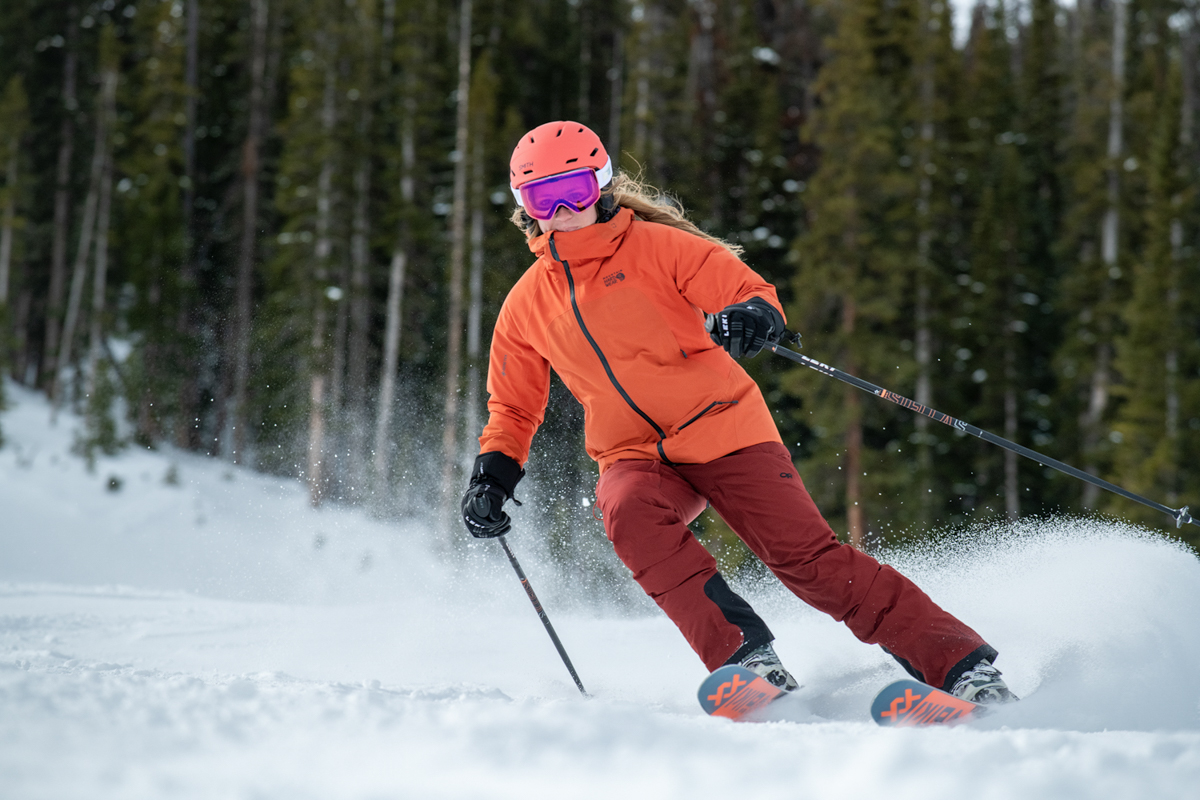
Ski jackets are generally designed for a specific purpose—whether it's for resort riding, backcountry touring, or a combination of both—so we've included a "best for" specification in our product blurbs and comparison table above. Since most skiers spend at least some time on chairlifts, most ski jackets are tailored to accommodate those needs. A shell designed for inbounds use should be durable, windproof, waterproof, and offer enough room to layer underneath. While insulation is optional for resort skiers, it can be particularly beneficial for cold lift rides in regions like the Northeast and Colorado. Finally, since there’s less of an emphasis on keeping weight low, modern resort designs often feature longer cuts (indicated by the center back length), roomier fits, and attractive, modern styling.
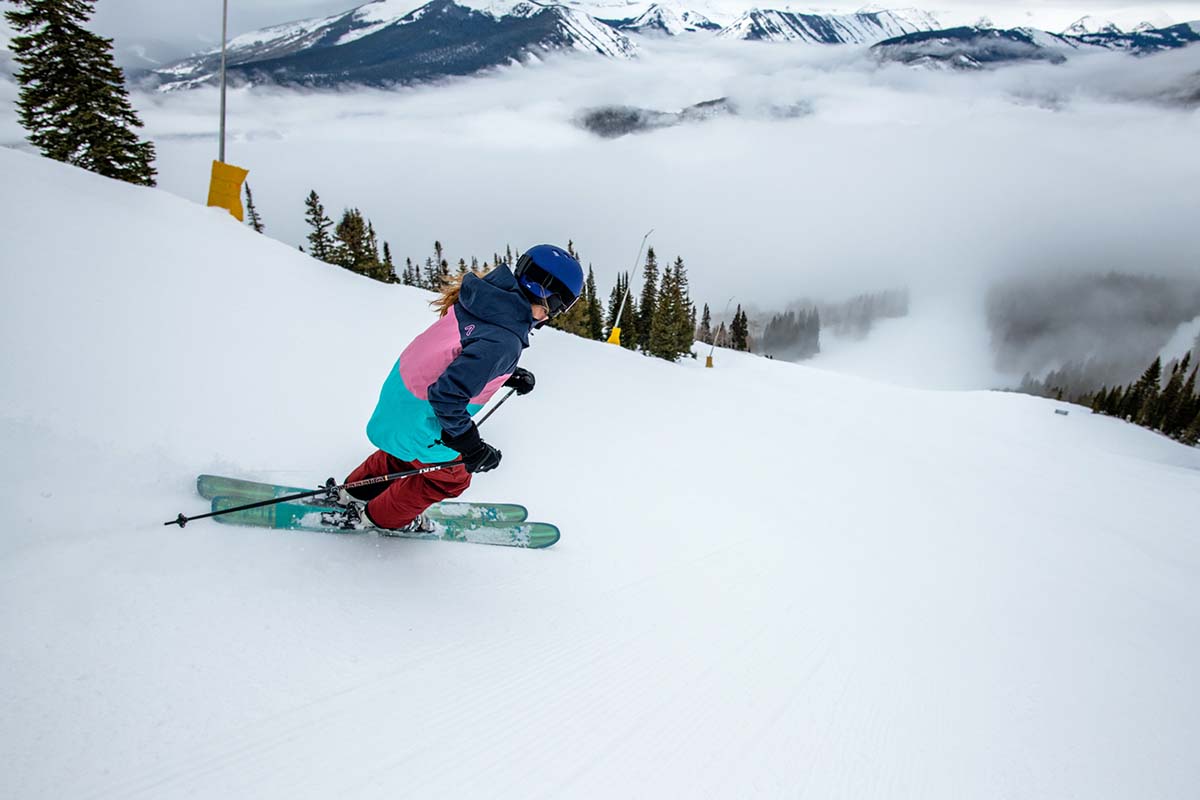
For ski touring, mountaineering, or sidecountry excursions, a lightweight, uninsulated shell is your best bet. The materials must be thin and packable, and there is a high priority on fabric technology to deliver top-notch performance at a low weight. Jackets that feature integrated stretch or softshell panels excel in breathability, but when faced with heavy wind and moisture, a premium hardshell remains the top choice. Fit depends on the intended activity—freeride shells are typically roomier, while touring-ready jackets are designed to fit more closely—but all prioritize freedom of movement. Lastly, jackets that bridge the gap between backcountry and resort use tend to offer a more versatile fit, with durable, breathable fabrics that still shield against wind and moisture. This balance is difficult to strike and often comes with a higher price tag, but designs like the Arc'teryx Sentinel and Patagonia SnowDrifter stand out for their versatility and high level of performance.
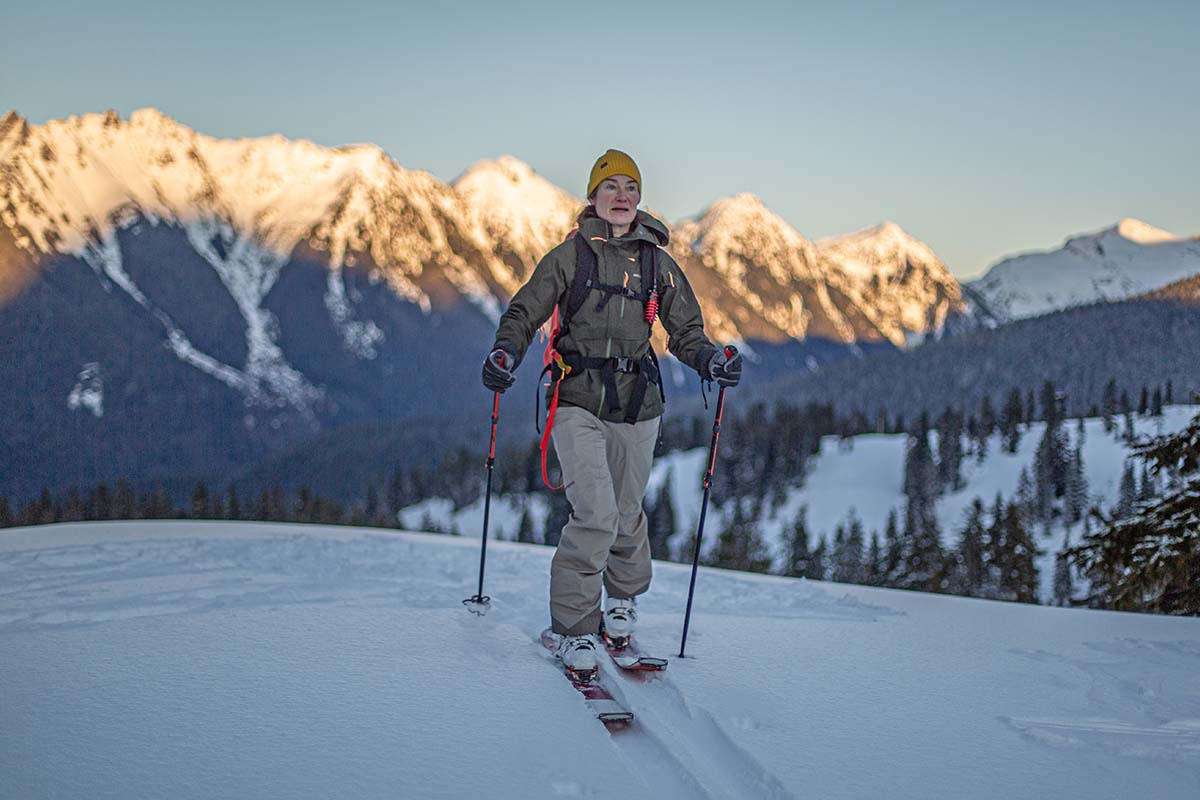
Ski jackets fall into three primary categories: shell, insulated, and 3-in-1. The best option for you will depend mostly on your skiing style and budget. Shell jackets are the most popular, offering versatility for everyone from casual resort skiers to backcountry adventurers venturing into harsh, wet conditions. Insulated jackets are ideal for inbounds skiing during cold winter days, while 3-in-1 jackets are nice for budget-conscious riders or those just starting to build their kit. Below is a brief summary of each type. For more details, check out our article on ski jacket types.
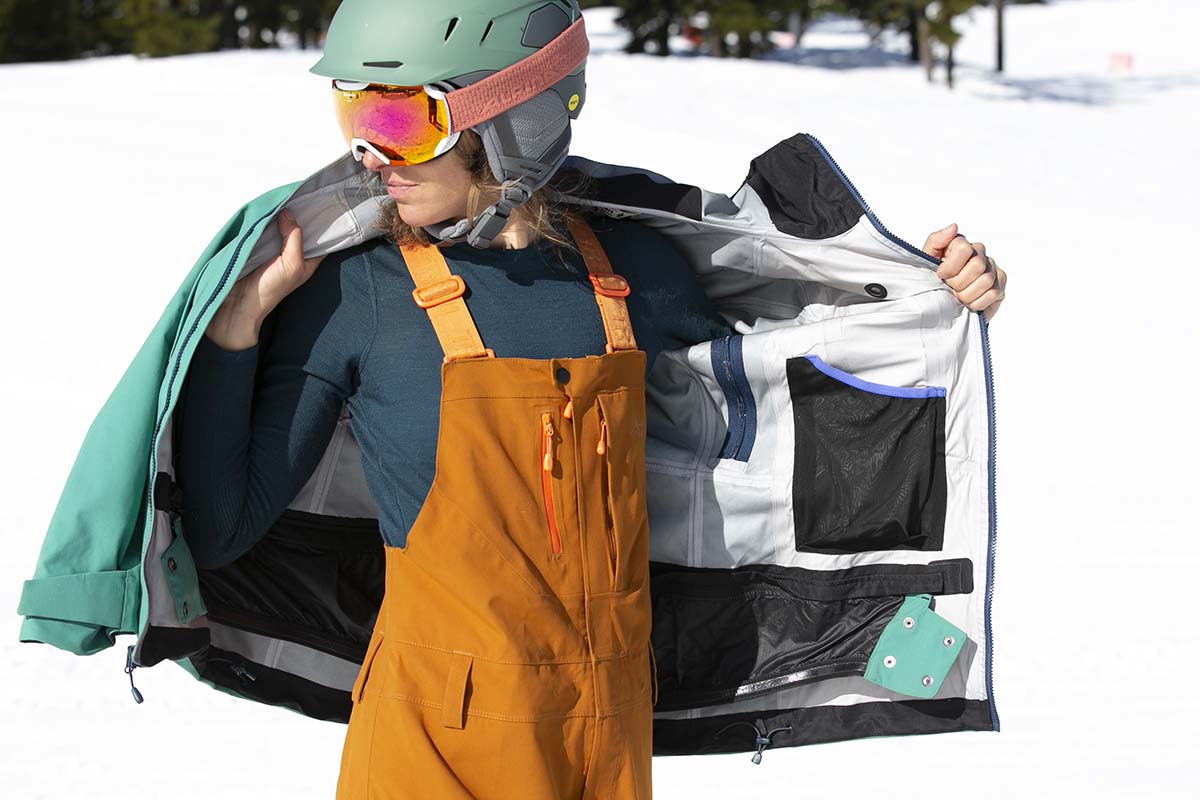
Shell (Non-Insulated) Jackets
Shell jackets deliver excellent protection against wind and moisture, making them ideal for both backcountry and resort skiing. These jackets are made with multiple layers of fabric laminated together, providing waterproof, windproof, and generally breathable performance. Since they are not insulated, you'll need to pair them with a midlayer and/or baselayer for warmth (for more, check out our tips on How to Layer for Backcountry Skiing).
High-end shell jackets, such as the Outdoor Research Skytour, feature advanced waterproof/breathable membranes (Gore-Tex and AscentShell are two of our top choices) and a tailored fit for great mobility. Some models have a rigid, crinkly feel, while many modern backcountry designs incorporate built-in stretch or softshell panels, offering excellent mobility and breathability with small compromises in wet-weather protection. Basic shells use thicker fabrics and lower-quality waterproofing that tends to be less breathable. While entry-level skiers will likely be fine with a “budget” jacket, we suggest upgrading to a higher-quality option if you ski regularly.
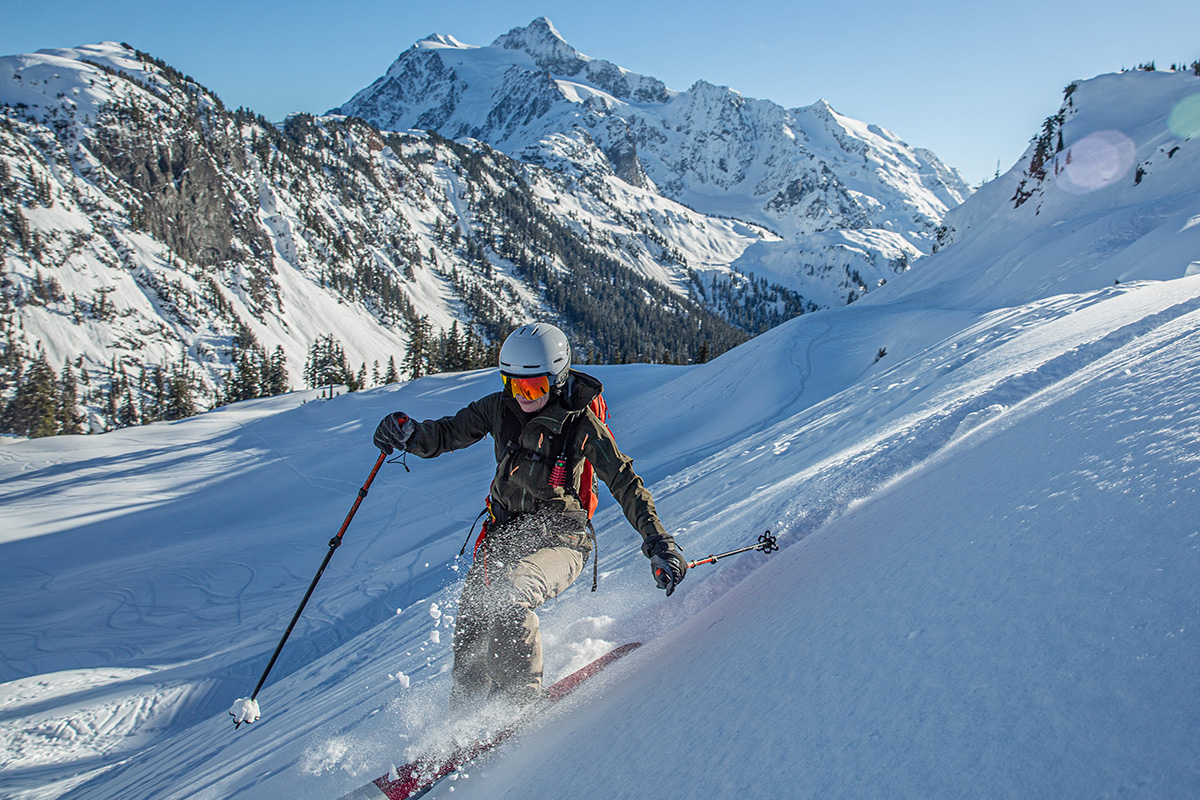
Insulated Jackets
An insulated jacket typically combines a weather-ready shell with synthetic insulation, offering excellent protection against both moisture and cold. These designs are a good match for resort skiers who will benefit from the added warmth during chilly chairlift rides and frigid downhill laps. Synthetic fill is very common due to its affordability, breathability, and the fact that it maintains its insulating properties when wet (unlike down fill, which clumps up). Premium options provide more warmth with less bulk (PrimaLoft Gold and Patagonia's PlumaFill are two top choices), while budget-friendly jackets tend to be bulkier, heavier, and prone to overheating. Regardless of the insulation type, insulated jackets are generally heavier, less breathable, and more restrictive than uninsulated shells. While these aren’t major concerns for resort use, they will be dealbreakers for most backcountry skiers.
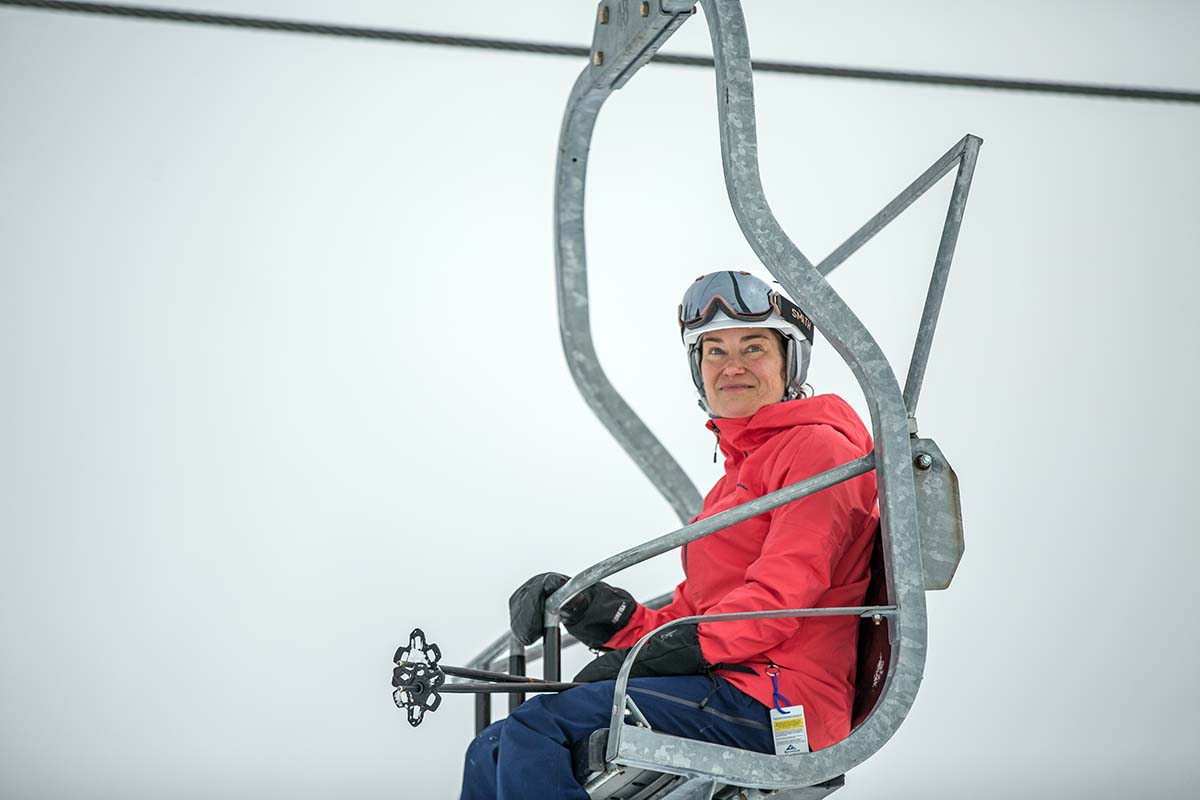
If you choose an insulated jacket, it’s important to consider how much warmth you really need. Most jackets have thicker insulation in the body and lighter fill in the arms and hood. A heavily insulated jacket is great in cold weather but can feel too warm on milder days, making it less versatile for season-long use. We usually recommend moderate insulation, like what you get with Patagonia's Powder Town (80g in the body and 40g in the arms), as it gives you the option to add a midlayer for extra warmth on colder days while remaining comfortable when the sun peeks out and the temperatures rise. To be sure, heavily insulated jackets have their place, but most skiers will benefit from a more balanced option.
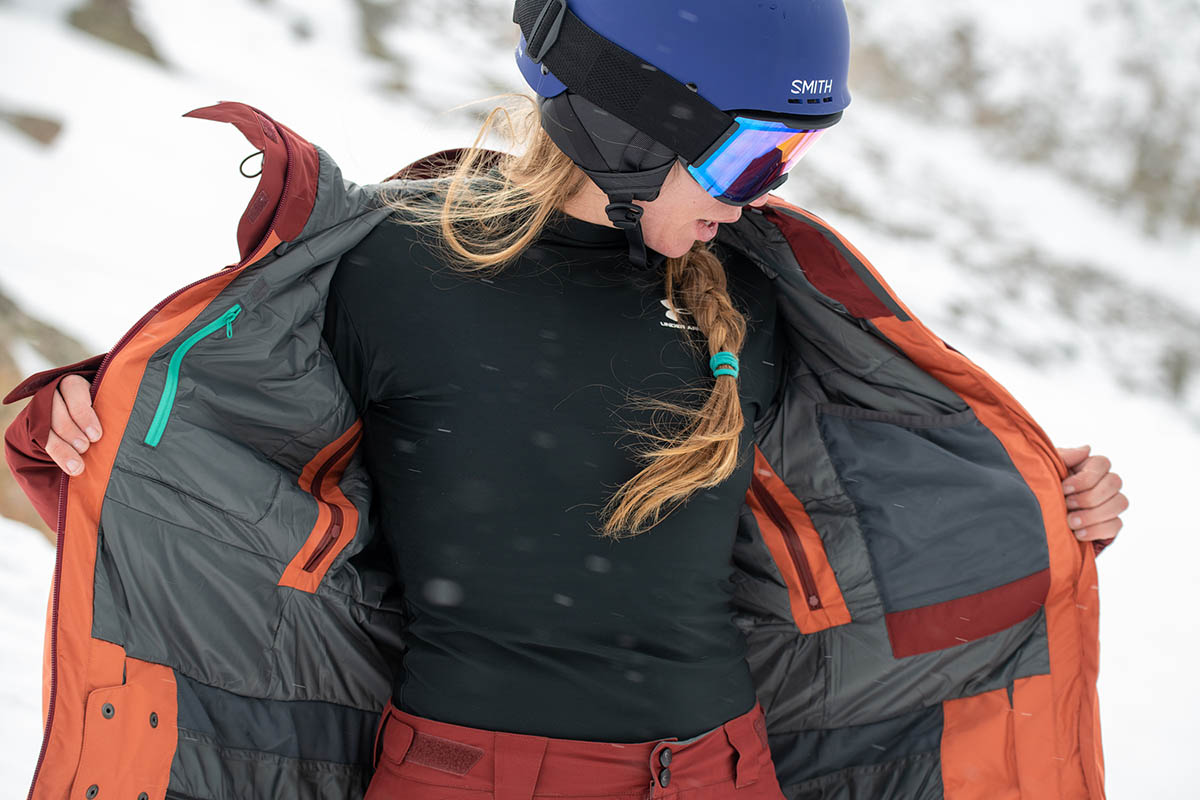
3-in-1 Jackets
3-in-1 jackets, which combine an outer shell with a zip-in insulated layer, are a favorite among casual skiers. They’re pretty cost-effective: You can usually find a quality 3-in-1 jacket priced between $200 and $400, and—true to the name—you get the versatility of three jackets in one. You can wear just the shell on warmer spring days, zip the two layers together for colder winter conditions, or use the midlayer (typically a fleece or synthetic jacket) on its own for everyday wear. The versatility is hard to beat, and unlike insulated jackets, you can easily remove the warming layer by simply unzipping it.
That said, 3-in-1 jackets tend to be bulkier and heavier because of the extra zippers, and combining the shell with the insulating layer can restrict your range of motion. Additionally, when the midlayer is zipped into the shell, its pockets are inaccessible, and weather protection and breathability are often middling as a result of cheaper materials and downgraded membranes. These jackets also aren’t ideal for high-exertion activities, though opting for one with pit zips can improve ventilation. However, for budget-conscious riders or those who ski only a few times a year, a 3-in-1 like the TNF ThermoBall Snow Triclimate or Columbia Bugaboo III offers a great way to get a full setup without breaking the bank.
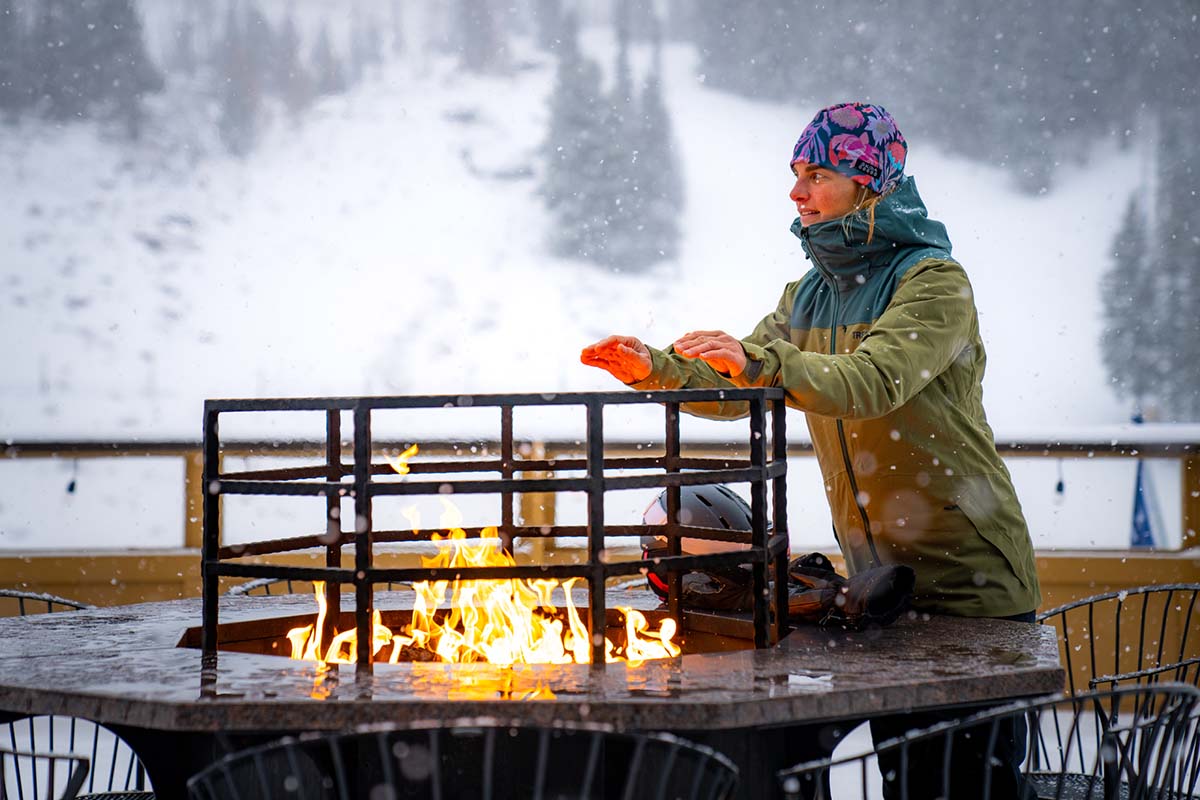
One figure you’ll often come across when researching ski jackets is the number of fabric layers (2L or 3L). A 2-layer jacket bonds the outer face fabric to a waterproof membrane and features a separate liner inside, while a 3-layer jacket combines all three layers into one cohesive piece. In terms of price, 2-layer membranes are usually found on entry-level to mid-range resort jackets, such as REI's $299 Powderbound and Patagonia’s $399 Insulated Powder Town. Moving up to a 3-layer design typically pushes the price beyond $400.
Both construction types come with inherent performance advantages and drawbacks. 2-layer jackets are a favorite among resort skiers due to their solid weather protection and durability at an affordable price. However, they tend to be less breathable, and the extra liner adds weight and bulk—issues that aren’t significant for inbounds use but will deter most backcountry-goers. For active resort skiers and those who prefer to earn their turns on the skin track, a 3-layer jacket is the best bet, offering improved range of motion, comfort, and a lighter weight. 3-layer jackets also provide better breathability, and high-end models (like those with Gore-Tex) offer unmatched protection in harsh conditions. Overall, both 2- and 3-layer options work well for resort skiing, but for ski touring and backcountry activities, we recommend a 3-layer design. For more information, check out our article: Ski Jacket Construction: 2L vs. 3L.
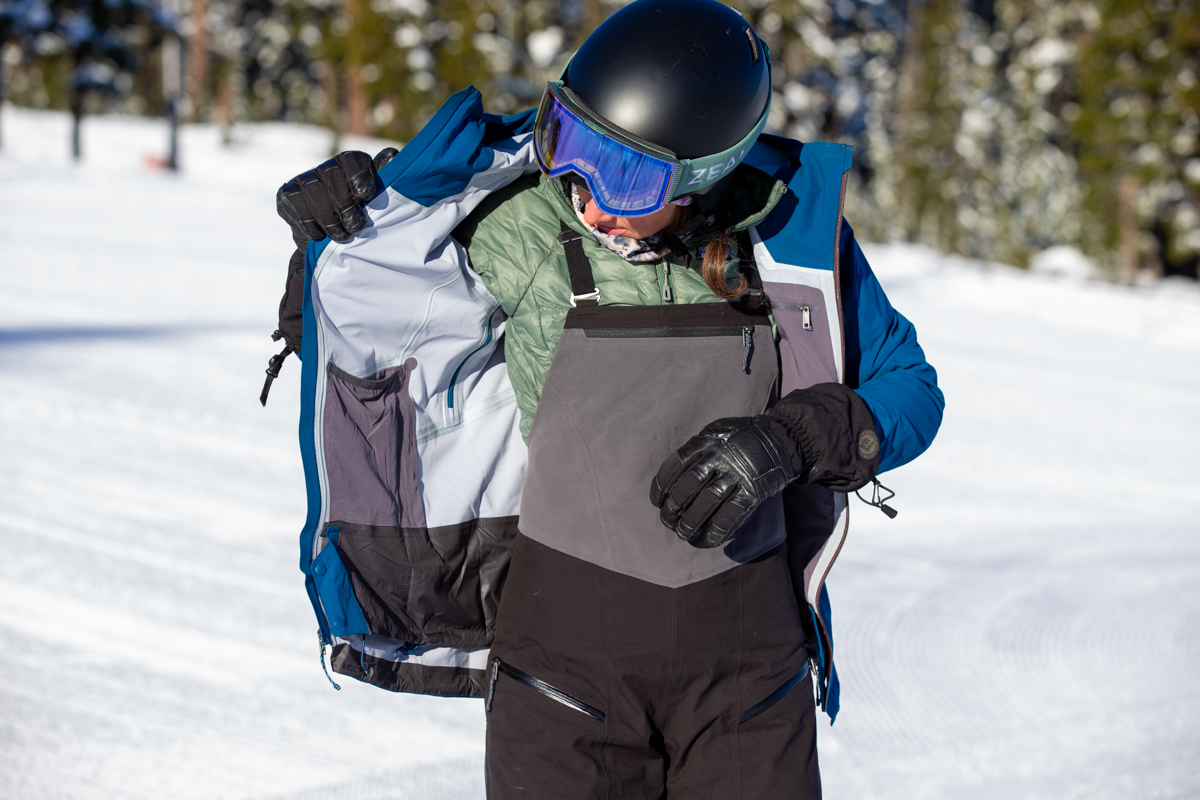
Ski jackets are typically waterproof across the board, ranging from affordable $200 models to premium Gore-Tex (or similar) shells. This performance is achieved through the use of waterproof laminates and DWR (durable water-repellent) coatings, which help shed wet snow and prevent moisture from penetrating the outer fabric. Backcountry-specific softshells are an exception, as they lack a waterproof membrane and will eventually allow moisture to seep through (it’s for this reason that there are currently no softshells featured on our list).
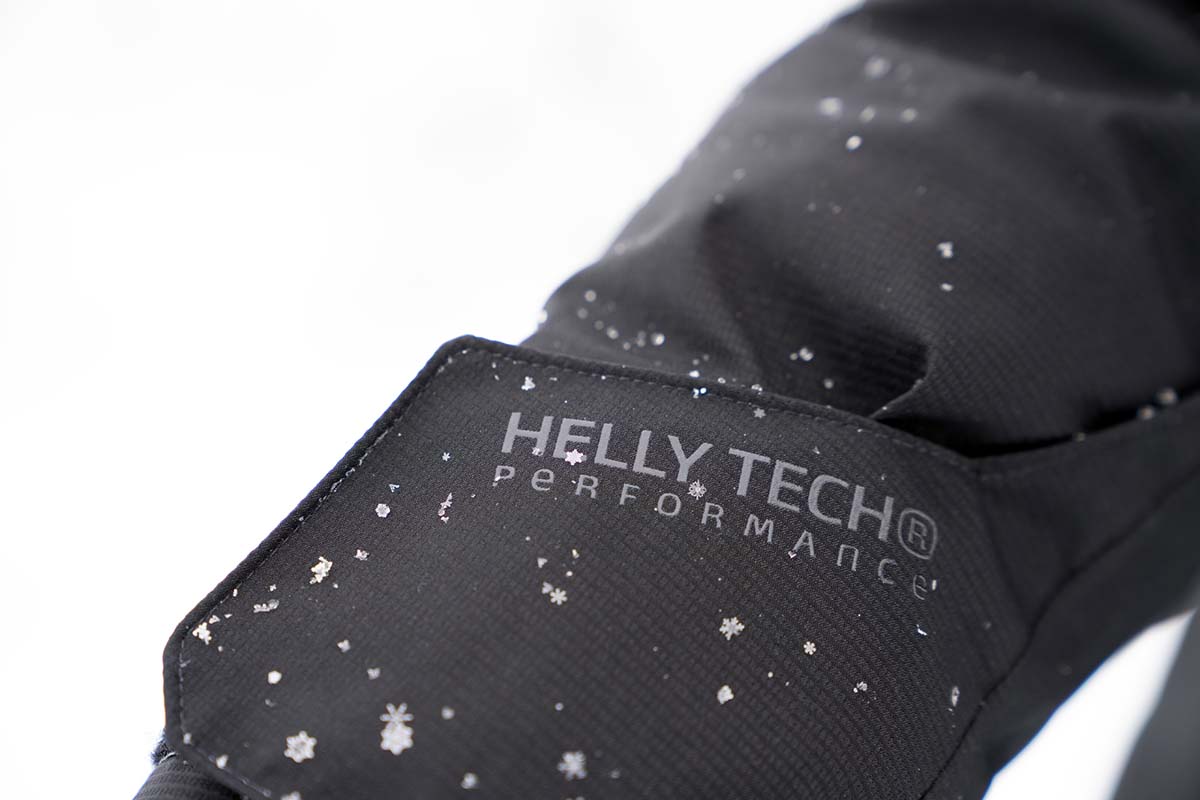
Waterproof options vary widely in terms of performance. Budget-friendly jackets will keep you dry in cold, snowy conditions but tend to soak through more quickly in rain or slush. This is typically due to lower-quality face fabrics and membranes that absorb moisture more readily, along with a lack of full seam taping. For casual resort-goers, budget designs are often sufficient since you can always retreat to the lodge to dry off, but they’re not ideal for serious shredders or backcountry adventurers.
Moving up on the performance spectrum, a high-quality 2-layer jacket like Patagonia’s Powder Town or Helly Hansen's Alphelia is an excellent choice for most resort skiers. For the majority of backcountry riders, a lightweight and stretchy 3-layer jacket, such as the Patagonia SnowDrifter, offers a solid balance of breathability and waterproofing. When it comes to the harshest winter conditions, nothing beats a premium hardshell with a thick face fabric and premium waterproofing technology. Leading the pack are durable Gore-Tex shells like the Arc'teryx Sentinel and Norrøna Tamok, which perform exceptionally well in brutal winds and heavy snow, even during sustained onslaughts.
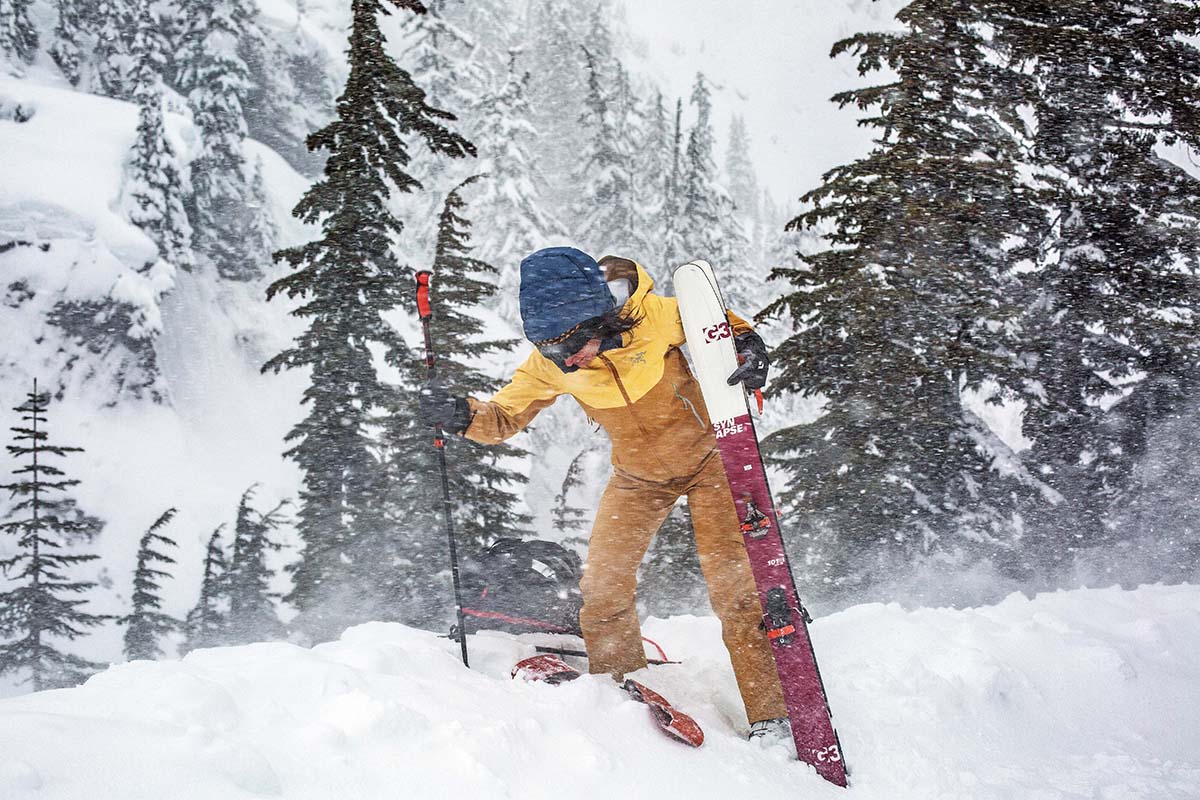
For most resort skiers, breathability isn’t the main concern when selecting a jacket. While it’s possible to work up a sweat on the slopes, you can easily manage heat by opening up the pit zips or shedding a layer during breaks at the car. However, for skiers who prefer to earn their turns, a well-ventilated jacket becomes essential. Shell jackets are the best performers in terms of breathability, particularly those made with high-end 3-layer fabrics like Gore-Tex and AscentShell. Those with thin, stretchy face fabrics tend to ventilate better than thicker, more rigid hardshells (as a comparison, the Outdoor Research Skytour versus the Arc'teryx Sentinel). If you’re willing to sacrifice a bit of wind and water resistance (we often are on sunny spring days), softshell jackets or hybrid designs lead the pack since they forgo the waterproofing layer.
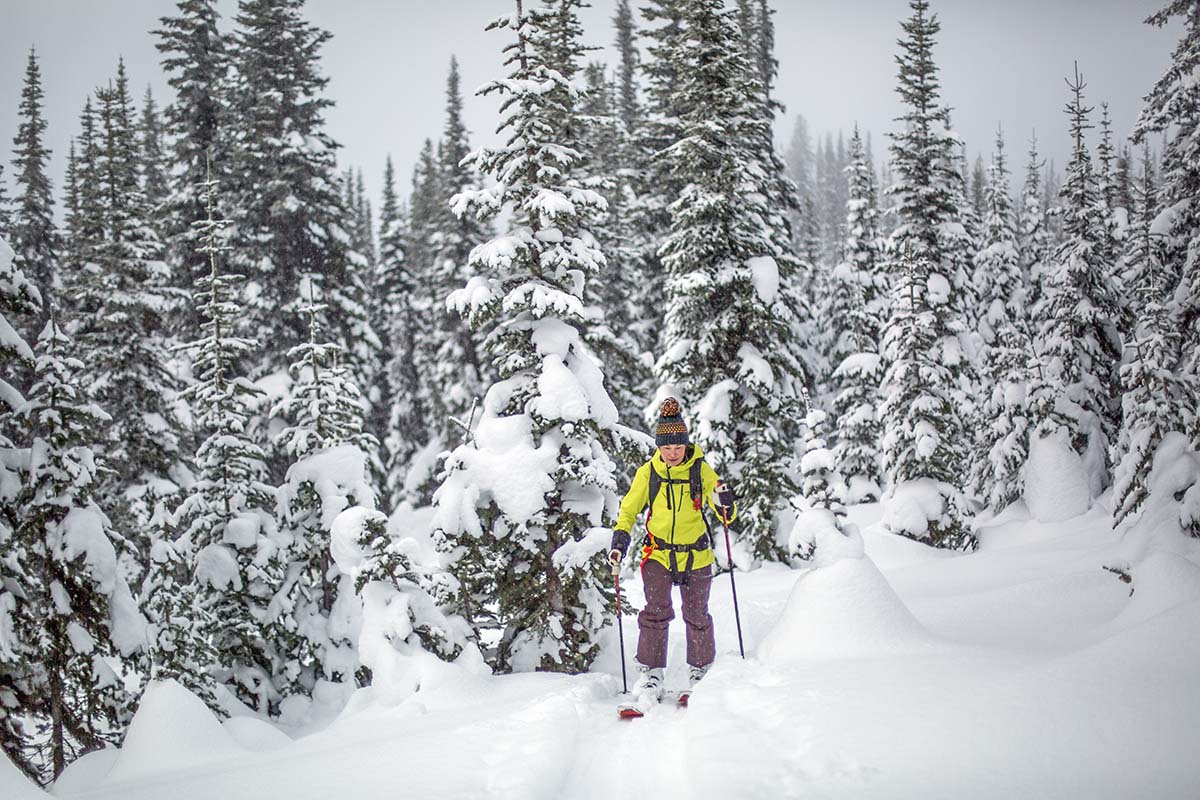
Skiing can be rough on gear—from getting on and off the lift to hiking and riding off-trail, your outer layers endure significant wear and tear. That’s why ski jackets are built with durability in mind. Fabric thickness is measured in denier (D), with a higher number representing a stronger, more durable material. Resort skiers usually benefit from a thicker, more robust construction, with some jackets reaching 100D or more (like the 200 x 320D Trew Gear Astoria). If you prioritize mobility but still want something durable, jackets with around 80D, like the Arc’teryx Sentinel, strike a nice balance. For backcountry shells, the focus is on minimizing weight, so they tend to be thinner (usually around 40D), including designs like the Outdoor Research Skytour (40 x 65D). While some manufacturers don't list a denier spec, you can typically expect thicker builds for resort shells and slightly less durability with designs intended for active or touring use.
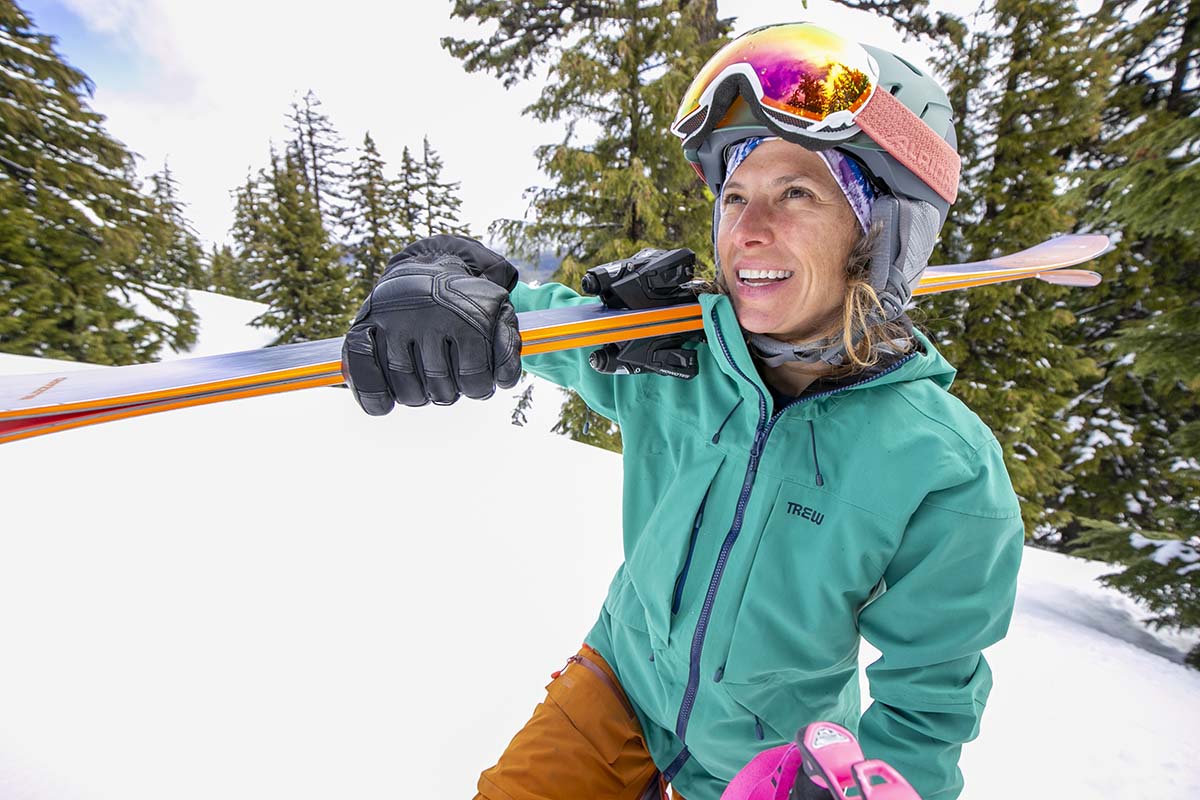
For resort skiers, jacket weight isn't typically a major consideration. As long as you’re comfortable, you likely won’t notice a few extra ounces, even with jackets like the 2-pound-4.5-ounce TNF ThermoBall Snow Triclimate, which is reasonable for a full day on the slopes. Cheaper jackets often use more fabric to make up for less advanced materials, leading to thicker and more durable shells. However, for those who hike or venture off-trail, a lighter jacket is a significant advantage. Jackets like the Outdoor Research Carbide (1 lb. 2.8 oz.) and Skytour (1 lb. 4.5 oz.) excel in this area. And weight typically correlates with packability, which again isn’t a concern for general resort use but is crucial for backcountry skiers with limited space in their packs.
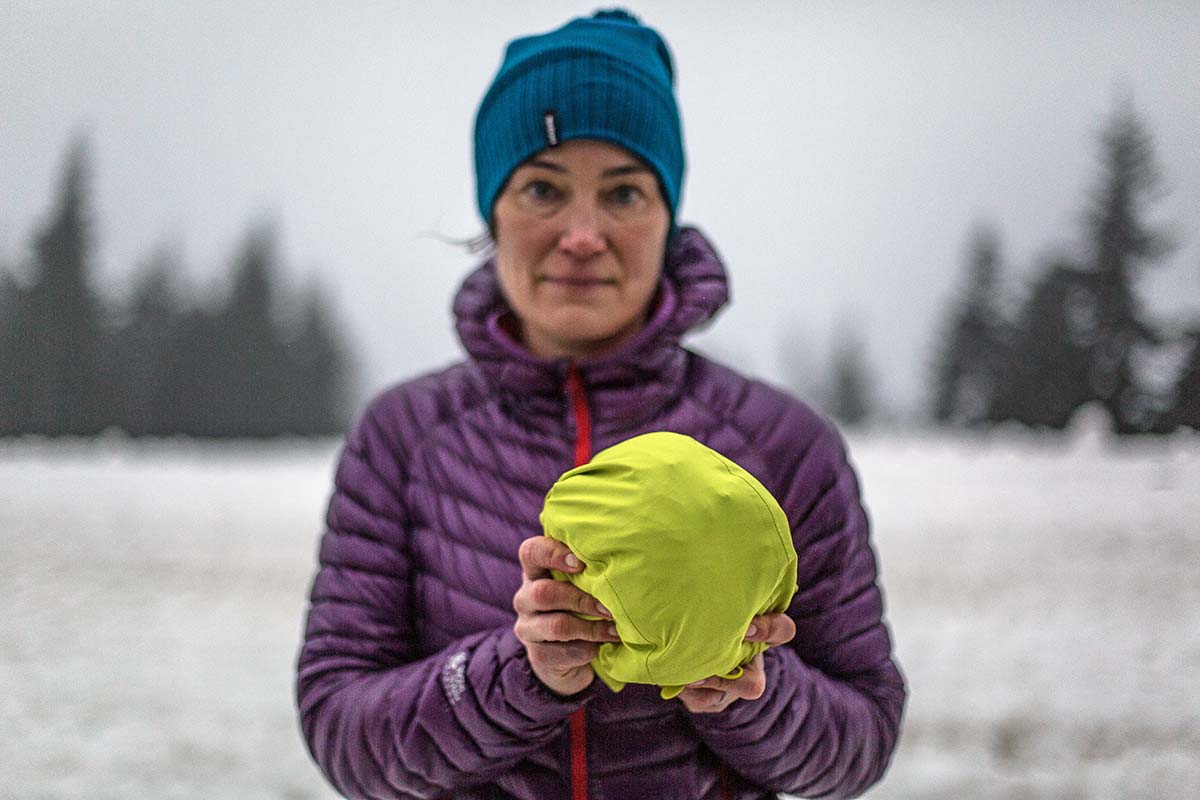
Hoods
Most skiers don’t use their jacket’s hood while downhill skiing, as a helmet typically provides enough protection and warmth. However, on particularly windy days—whether you’re inbounds or venturing outside the ropes—having a well-designed hood can be a game-changer, offering extra protection and helping seal the gap between your helmet and collar during cold, blustery lift rides. When shopping for a ski jacket, look for a hood that can easily fit over your ski helmet. While most hoods are sized to fit, it’s always a good idea to try it on with your helmet before buying. You’ll also want a hood with good adjustability, ensuring it stays snug on your head without obstructing your vision. Finally, if you plan to use the jacket for activities beyond skiing (such as wearing casually in the winter), make sure the hood fits comfortably when you’re not wearing your helmet.
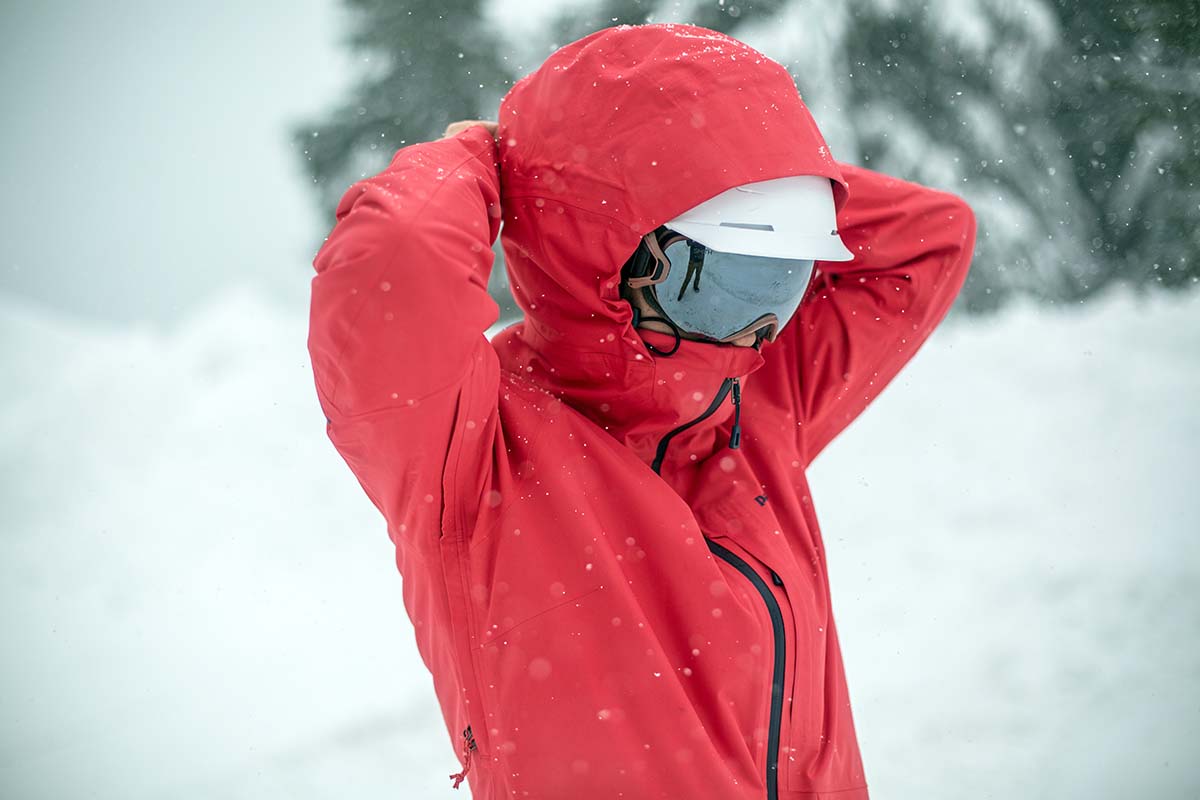
Pockets
If you don’t ski with a backpack, it’s important to pick a jacket that offers plenty of pocket space. Most ski jackets come with a couple of hand pockets and at least one zippered Napoleon-style chest pocket. This Napoleon pocket is perfect for holding smaller items like your phone, camera, or wallet, where your body heat can help keep them functioning smoothly. Some jackets—like the Helly Hansen Alphelia—even include insulated pockets to minimize battery drain on your electronics.
We also consider internal dump pockets to be essential for days on the slopes. Spacious, easily accessible, and close to your body’s warmth, they offer an ideal spot to store gloves, goggles, or glasses between runs or if you start to overheat while hiking. Additionally, dump pockets are a practical option for backcountry skiers who need a place to stash their climbing skins on a short descent (they’re also great for thawing out skins). Finally, many resort-oriented jackets feature a sleeve pocket on the arm, providing easy access to your ski pass and compatibility with RFID passes and electronic gates.
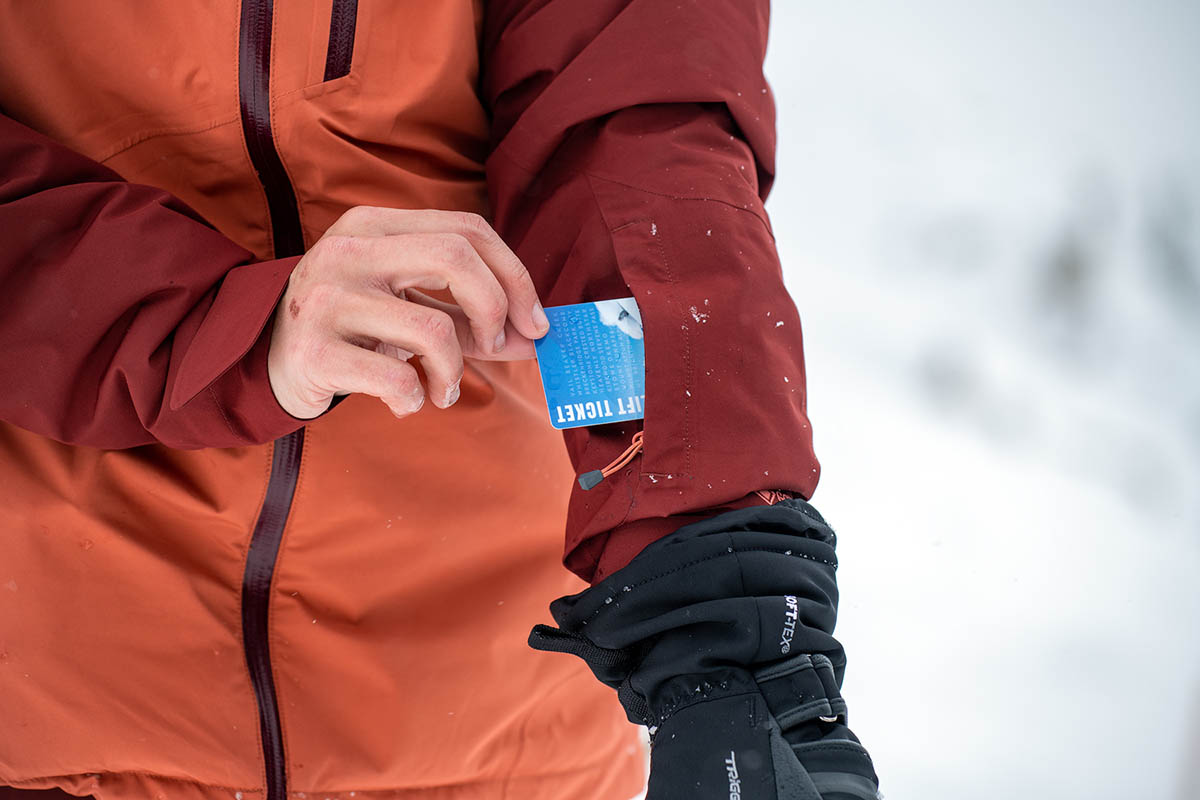
Powder (Snow) Skirts
While it’s nearly impossible to fully seal out snow if you ski through deep powder or take a big fall, a powder skirt still provides an excellent layer of protection. Also referred to as a snow skirt or powder gasket, this elasticized fabric is built into the jacket lining around the waist and typically fastens at the front to create a seal at the bottom hem. Powder skirts are most commonly found on resort-specific shells and burly backcountry designs, though they are often one of the first features to go when weight-saving is a priority. Some manufacturers even design their snow skirts to snap out of the way or detach entirely, which can be a useful feature for casual wear.
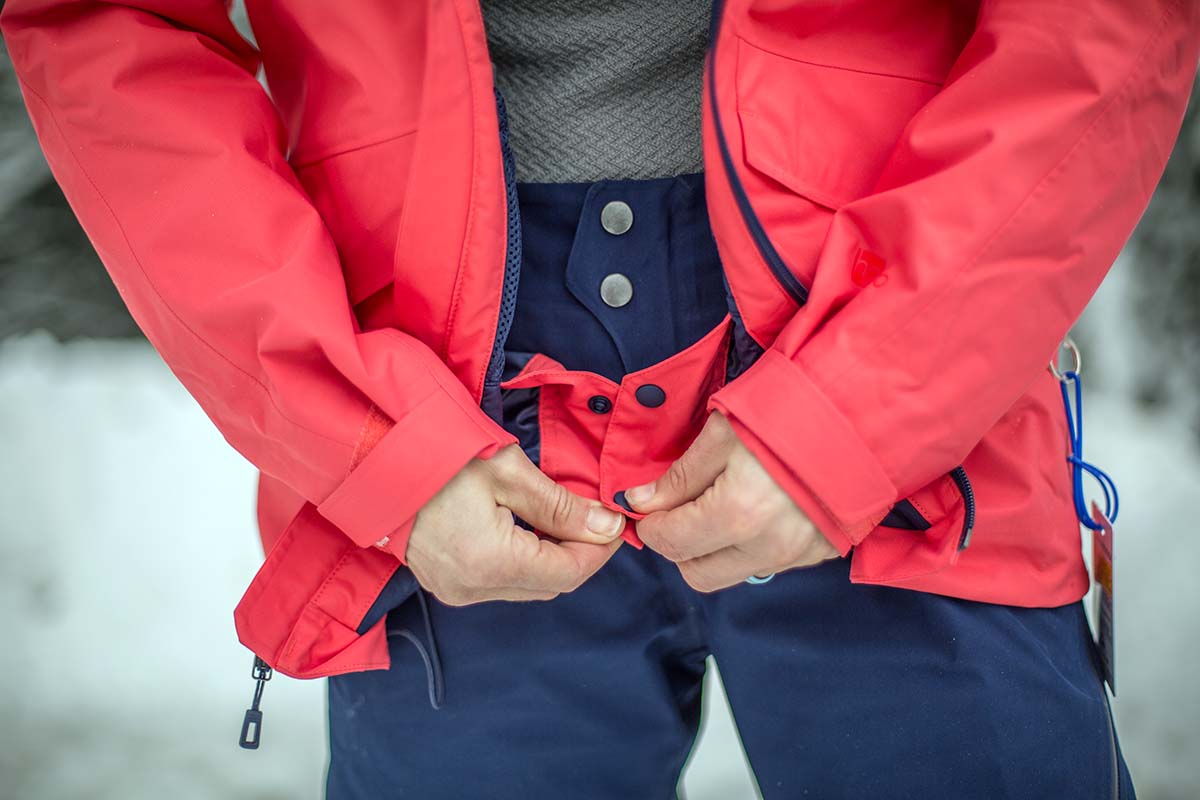
Jacket-to-Pant Attachment Systems
Similar to the powder skirt, jacket-to-pant attachment systems are designed to enhance warmth and protection. There isn’t much variation across the ski market, with most designs featuring a simple button on the powder skirt that connects to a corresponding piece on your pants (Patagonia, for example, uses a fabric loop). The advantage of this connection is that it creates a more secure seal against snow and cold, but it’s by no means essential for either resort or backcountry skiing. It’s important to note that, in most cases, you’ll need to buy ski pants from the same brand for the attachment system to work correctly. Many brands, like Outdoor Research and Black Diamond, skip this feature altogether.
Pit Zips
Skiing can be a physically demanding activity, and even the best waterproof jackets can limit airflow. That’s where pit zips come in. By opening them fully, usually from around your ribcage to just above your elbow, you can quickly release a lot of built-up heat. They’re not essential for easygoing skiers and do add some weight and bulk, but we put them on the active skier’s “must have” list. Some models even feature zips that extend all the way to the hem (look for designs with Outdoor Research’s TorsoFlo system), which provide excellent ventilation but aren't particularly practical.
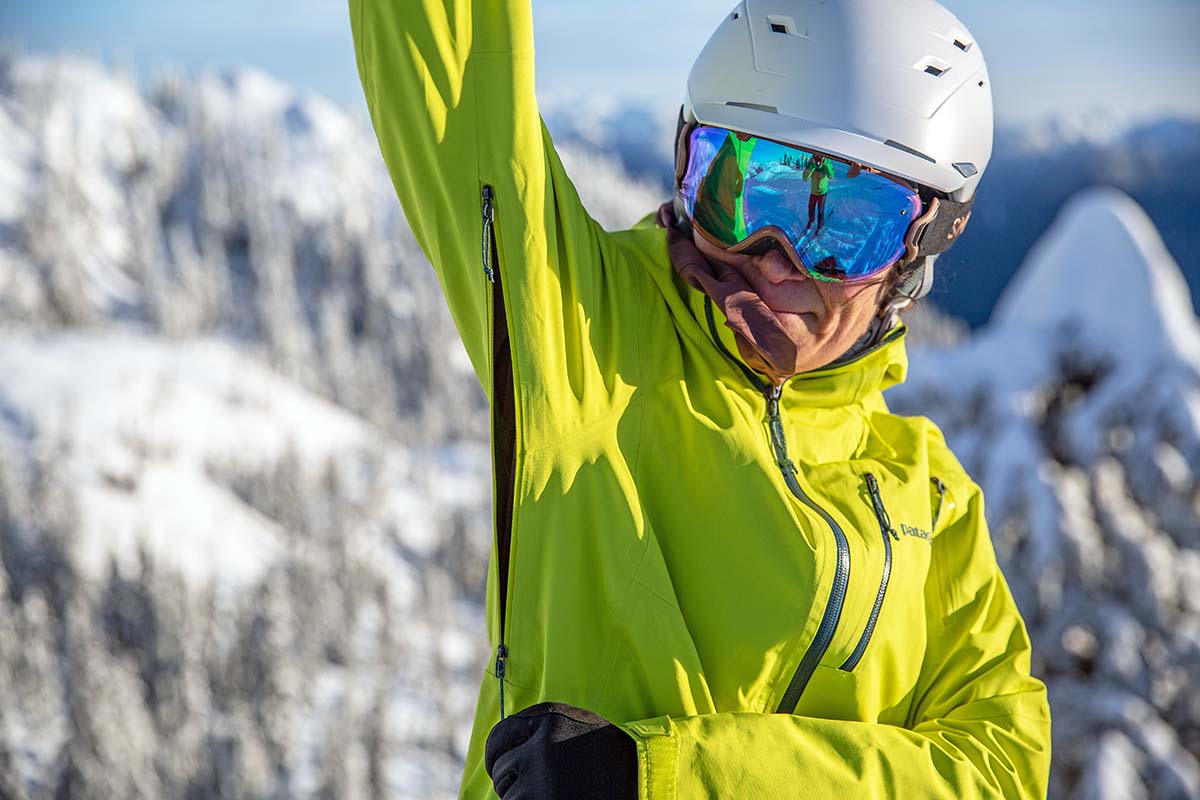
Recco
Many modern ski jackets come equipped with a built-in Recco reflector, a passive device that requires no batteries and can be picked up by Recco detectors, which are commonly used by resort search and rescue teams. This feature is particularly valuable for resort skiers who frequent areas prone to avalanches or tree wells. However, it’s important to note that a Recco reflector is not a replacement for an avalanche beacon. It uses simpler technology and emits a much weaker signal. While it provides an added layer of safety for resort skiers who occasionally venture off trail, sidecountry and backcountry skiers should always carry a full avalanche rescue kit, including a beacon, shovel, probe, and appropriate training.
Generally, the fit of a ski jacket aligns with its intended purpose. Resort jackets, like the Trew Gear Stella Primo, typically have a looser, more relaxed fit to allow for layering underneath. These designs often feature a longer cut with a drop-tail hem, providing added protection against cold chairlift seats. On the other hand, backcountry-specific jackets, such as the Outdoor Research Carbide, are streamlined to reduce bulk and enhance mobility. They’re snug enough for comfortable movement on the skin track while offering just enough room to add a puffy jacket underneath when transitioning or descending. Designs like the Arc'teryx Sentinel sit in the middle, offering a best-of-both-worlds combination: roomy enough to wear a midweight down jacket without feeling restricted but with great freedom of movement for hiking and occasional uphill travel.
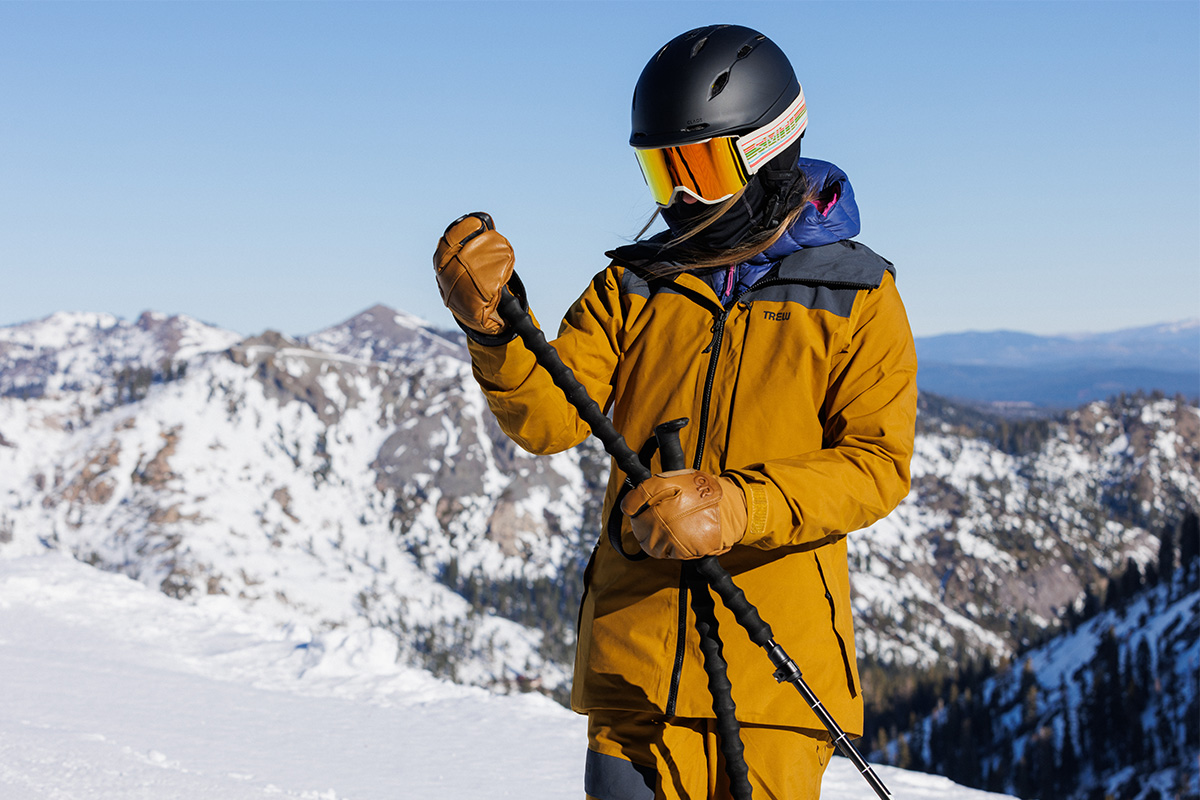
Plus-Size Ski Jackets
We’ve seen a big push in the outdoor industry for brands to offer apparel in more inclusive sizing, often referred to as plus or extended sizes. Technical outerwear like ski jackets are late to the game, but more and more options are slowly hitting the market. From our list above, The North Face’s ThermoBall Snow Triclimate, REI Co-op First Chair and Powderbound, and Columbia Bugaboo III are all offered in sizes up to 3X, and the Outdoor Research Carbide is available up to 4X. Trew Gear has also historically been a leader in bringing inclusive sizing to the ski industry. We applaud brands that cater to a wide range of body types and are excited by where the market is headed. For more information, see our article on the best plus-size outdoor apparel.
In recent years, the outdoor apparel industry has seen a significant rise in the use of sustainable practices, and ski jackets are no exception. Key initiatives include the use of recycled materials and PFAS-free DWR coatings, which forgo harmful perfluorocarbons (also known as “forever chemicals”) that have been linked to several health and environmental issues. Bluesign-approved fabrics are becoming more common, indicating that the materials were sourced and produced with a focus on minimizing their environmental impact. Many brands are also earning Fair Trade certifications, which helps ensure the fair and ethical treatment of workers. Finally, Gore’s latest ePE membrane deserves a mention as an eco-friendlier alternative to their standard ePTFE membrane. Though still carbon-based, Gore-Tex ePE is free of harmful PFAS, and it’s lighter and thinner, requiring fewer materials—thus, fewer pollutants—to produce.
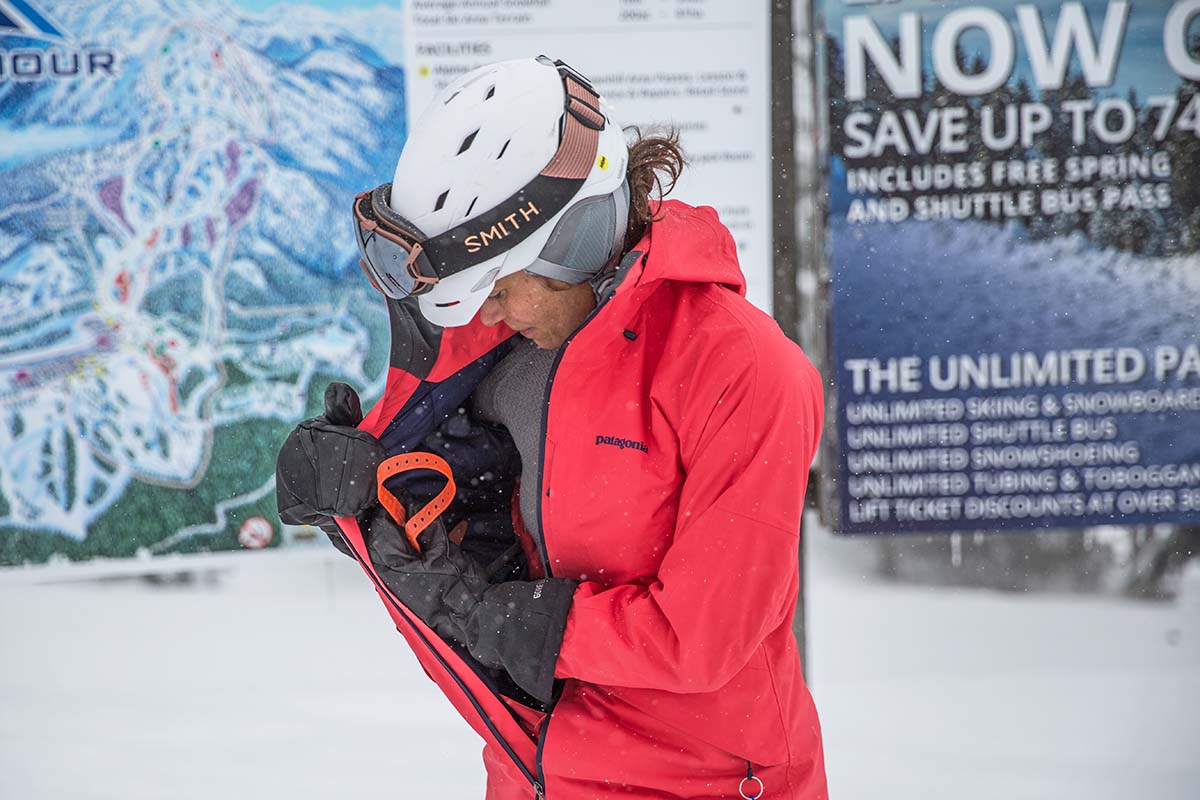
The good news is that many sustainability-conscious brands are transparent about their practices, clearly indicating which measures their products incorporate. Patagonia is a leader in this area: Their Insulated Powder Town Jacket, for instance, is Fair Trade Certified, features a 100% recycled liner, insulation, and shell, and is finished with a PFAS-free DWR coating. Other brands like Outdoor Research, REI Co-op, and Trew Gear (among many others) are also making significant strides. While there’s still a lot of progress to be made across the industry, the momentum from key players is certainly encouraging. Finally, a great way to shop sustainably is by investing in high-quality products that will last and opting to repair older gear rather than purchase cheaper items that will need replacing after only a season or two.
Unless you go with a 3-in-1 jacket, you’ll probably want a separate midlayer for skiing. The level of insulation varies widely, ranging from a lightweight fleece to a puffy down jacket. Fleece is a classic choice for ski midlayers, offering a nice balance between warmth and weight, although mid- and heavyweight versions can be bulky. Down jackets are the most expensive but provide unmatched warmth in a lightweight, compressible package (just be sure to keep them dry, as they lose their insulating properties when wet). Synthetic fill offers a solid middle ground, providing a good warmth-to-weight ratio, maintaining its insulating abilities even when wet, and offering better breathability than down. For more on midlayers and our top picks of the season, check out our article on the best midlayers.
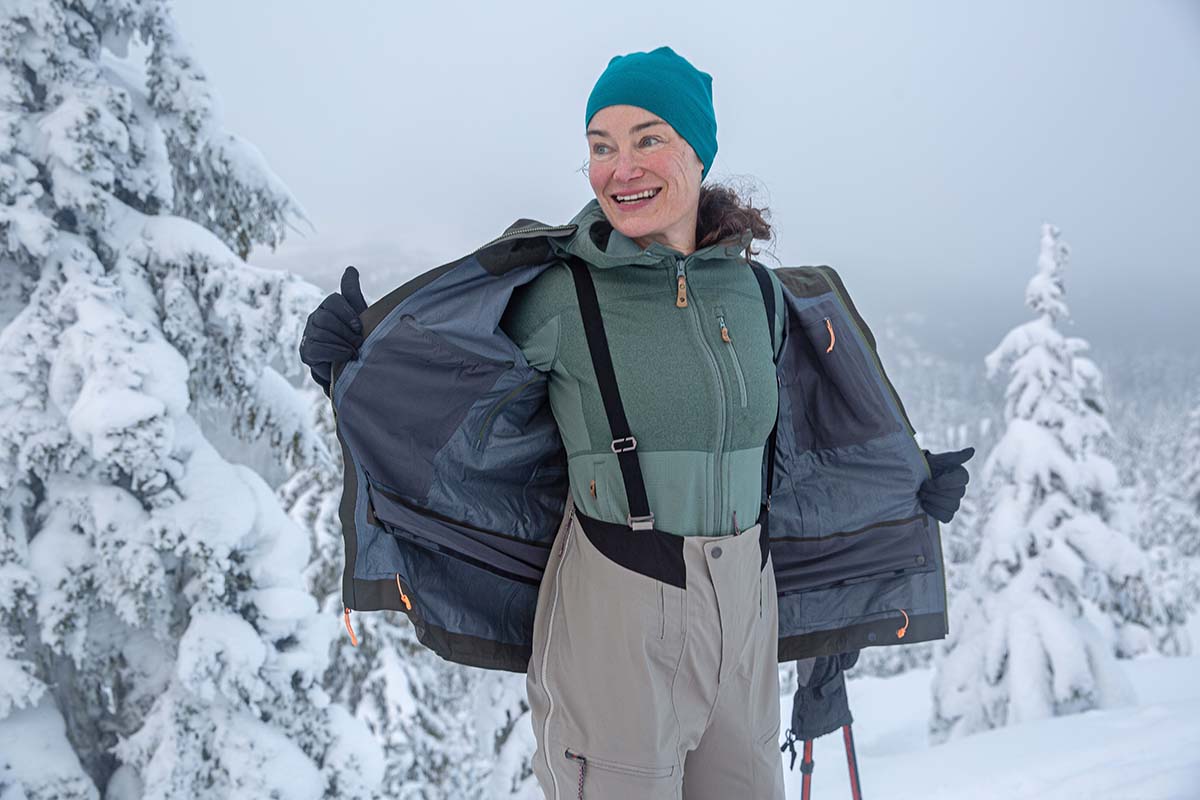
Baselayers play a crucial role in keeping you warm and dry. A breathable, well-ventilated jacket will only work as effectively as the baselayer underneath, so it's important not to skimp on this layer. Synthetic baselayers, such as those from Patagonia or Helly Hansen, offer great breathability and comfort at an affordable price. However, they tend to be less soft and more prone to retaining odor compared to merino wool. Merino is pricier but excels in both temperature regulation and stink resistance. For most conditions, lightweight or midweight baselayers are our top choice, offering the best balance of warmth and breathability.
Back to Our Top Women's Ski Jacket Picks Back to Our Women's Ski Jacket Comparison Table